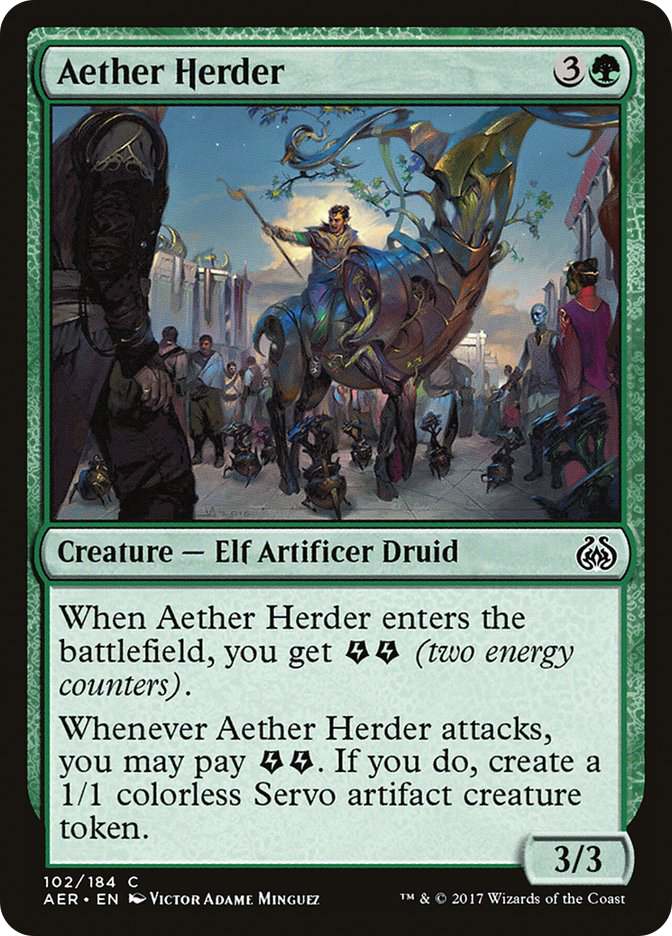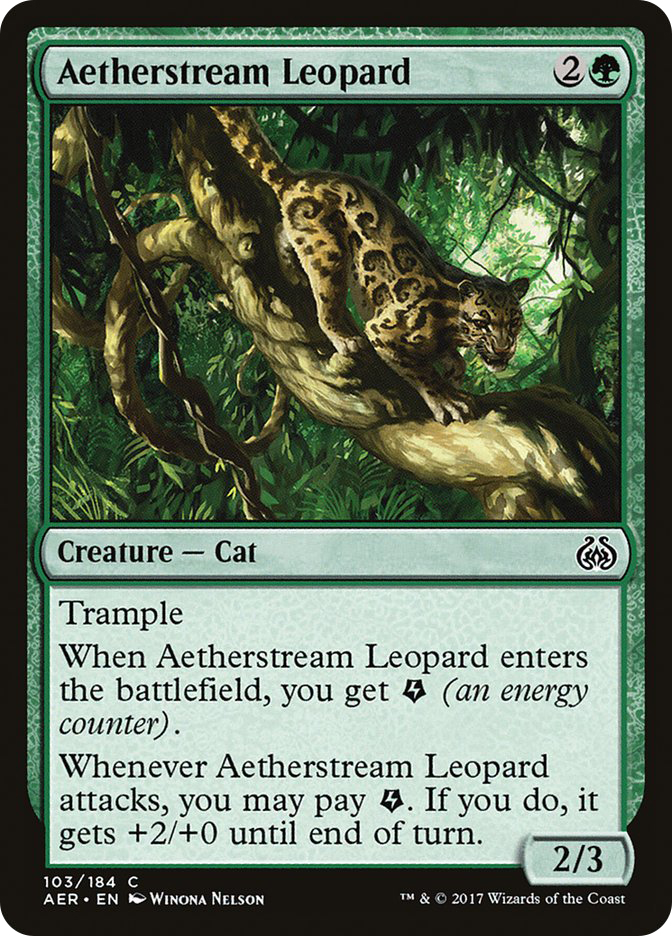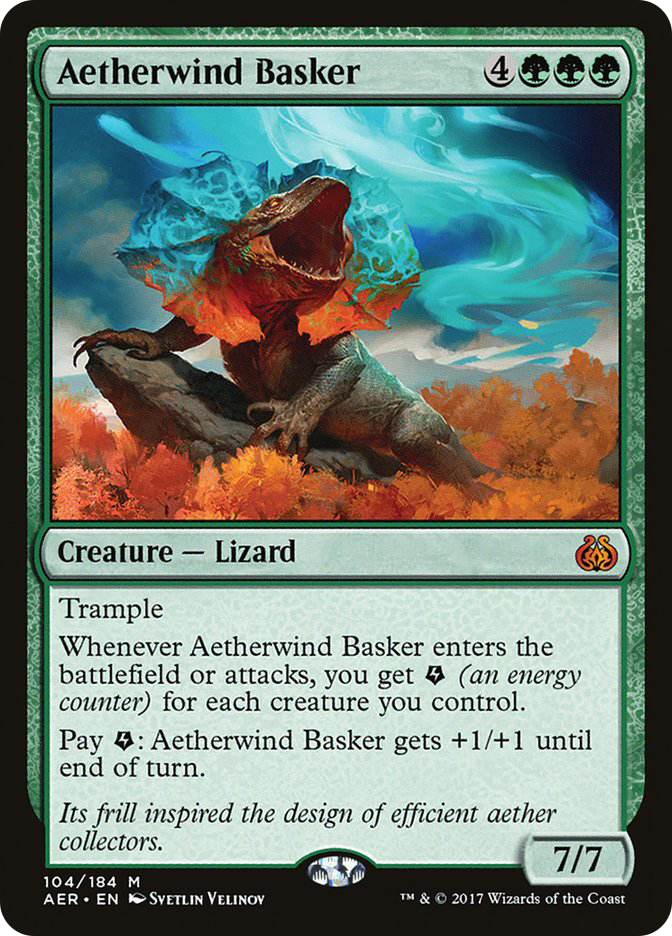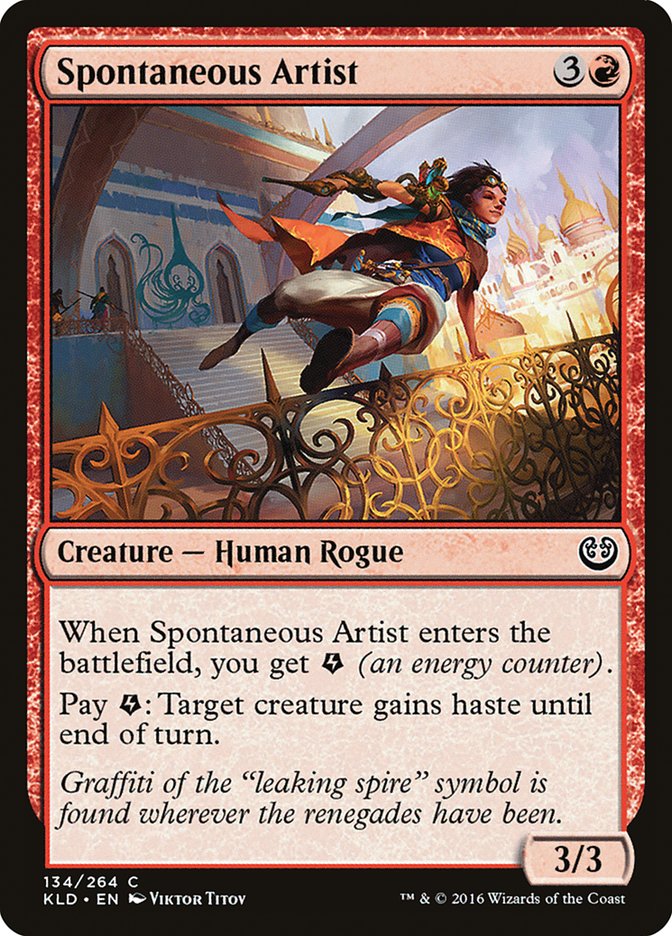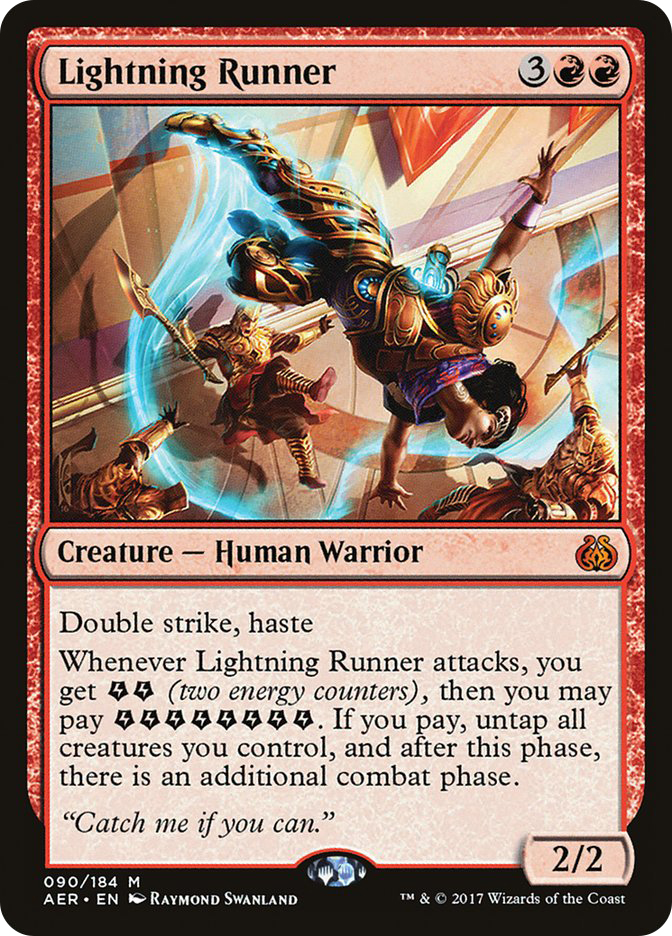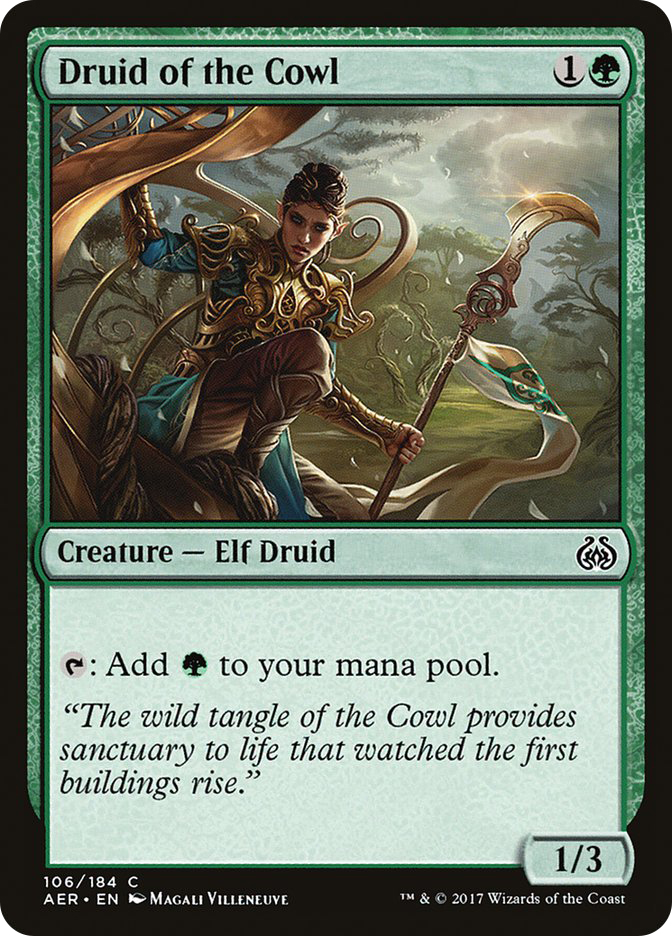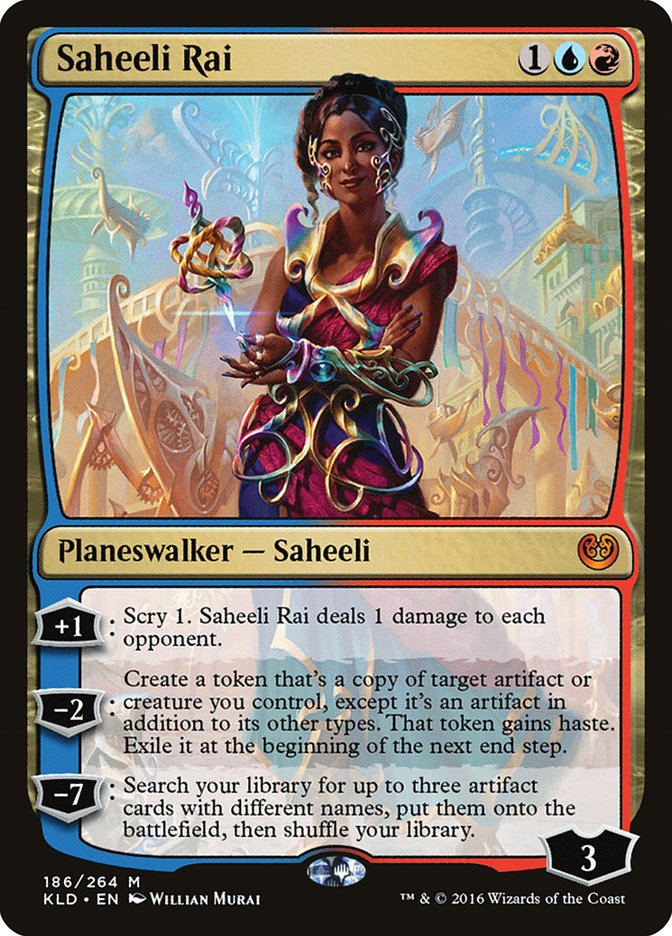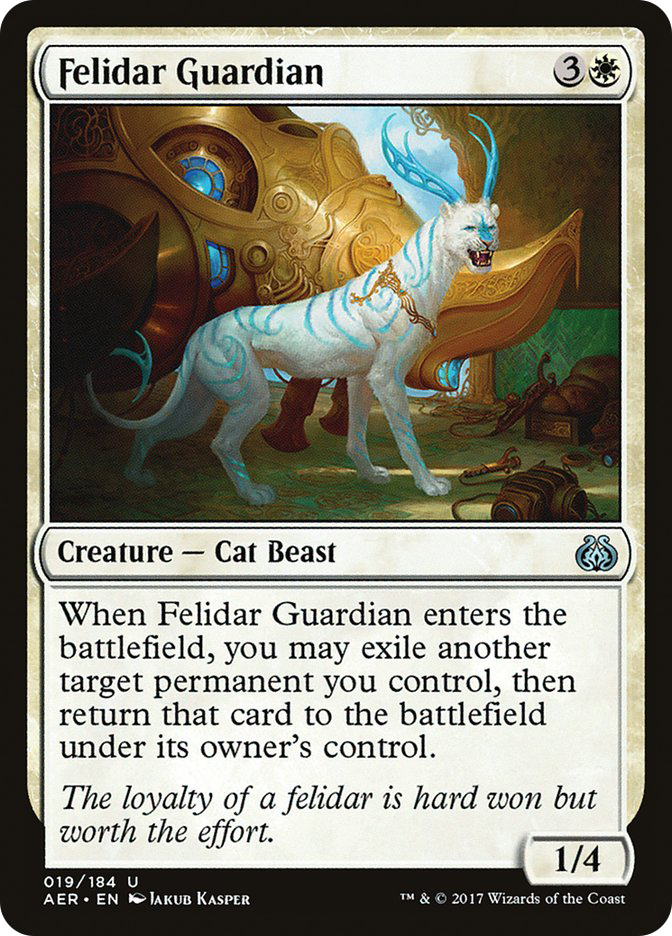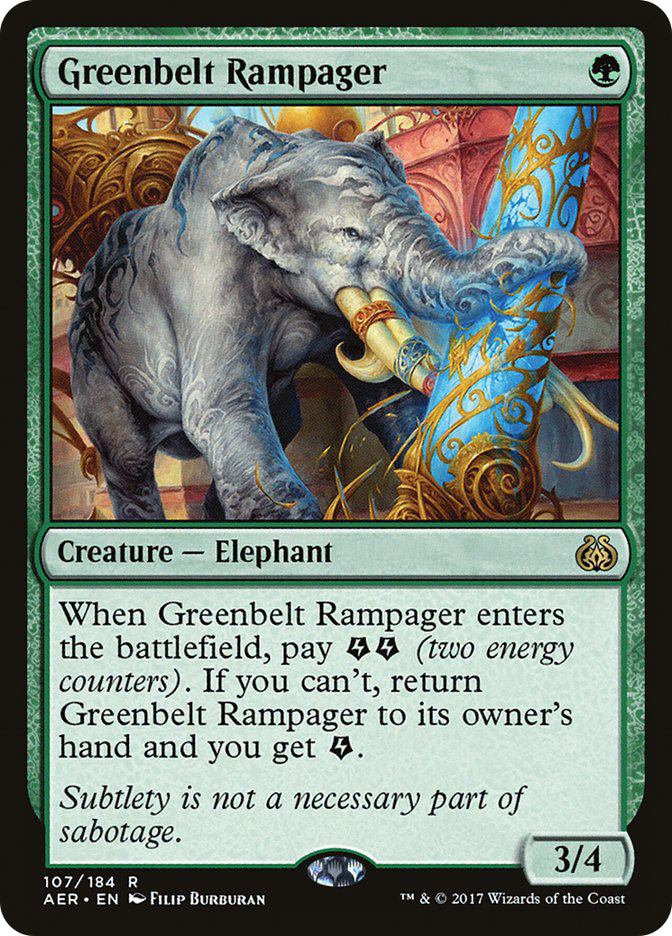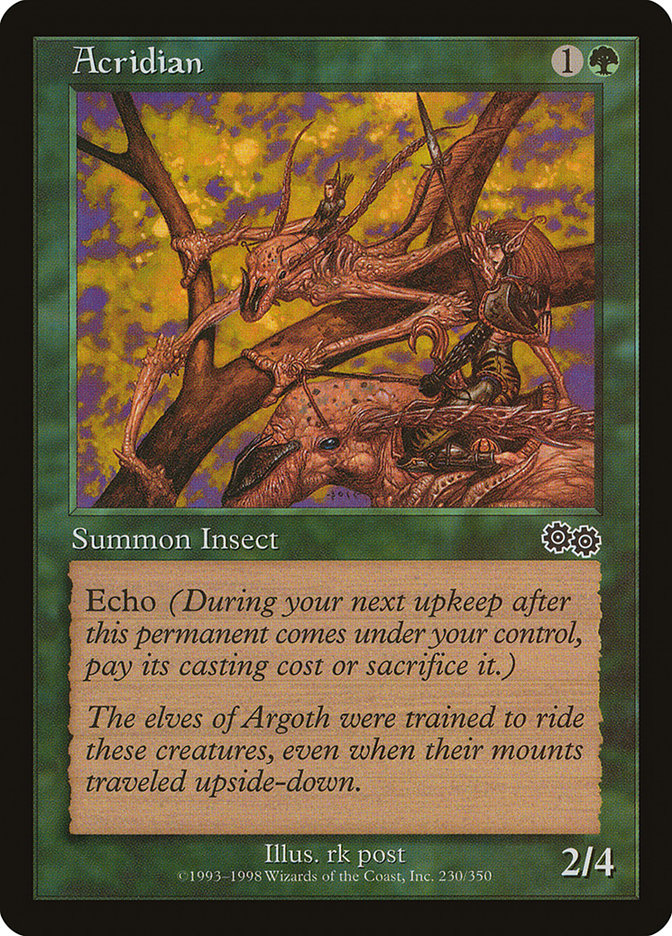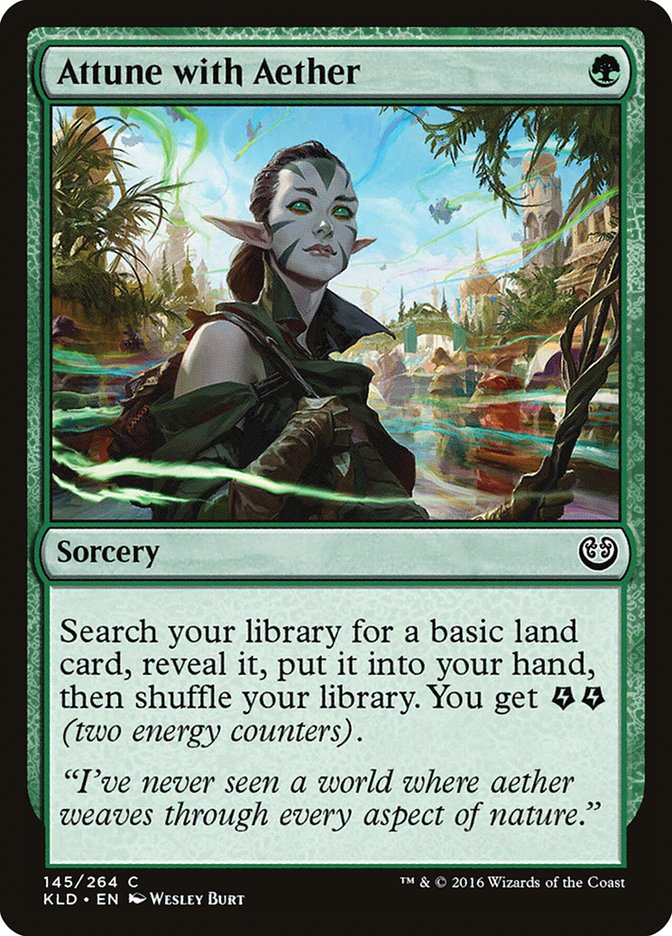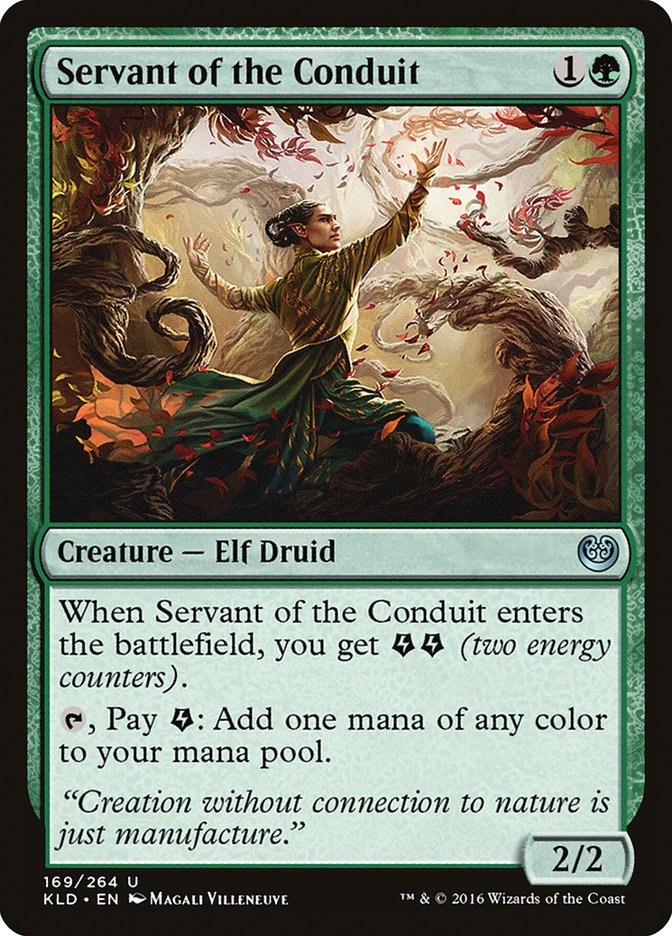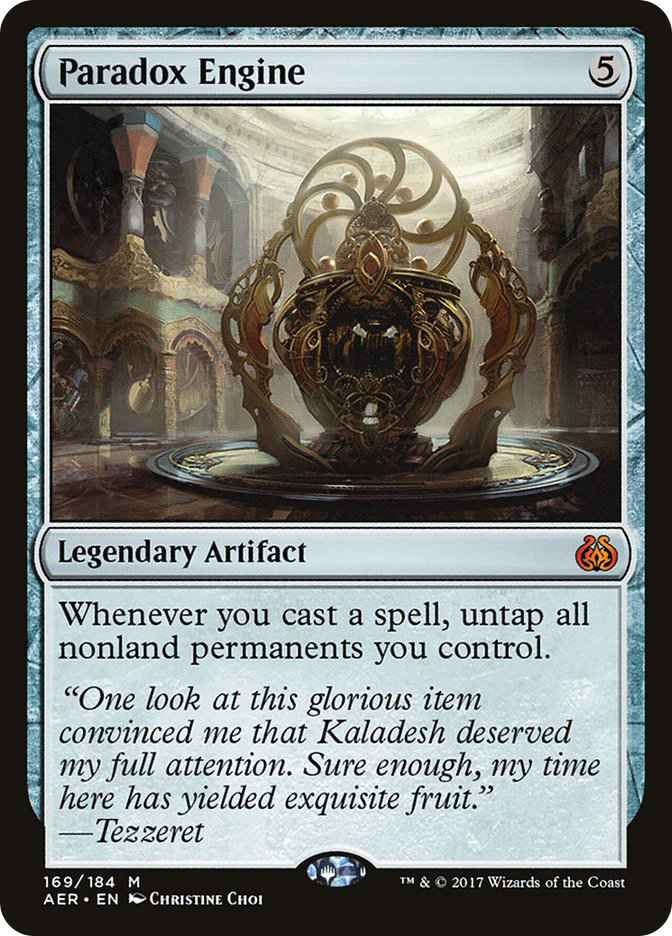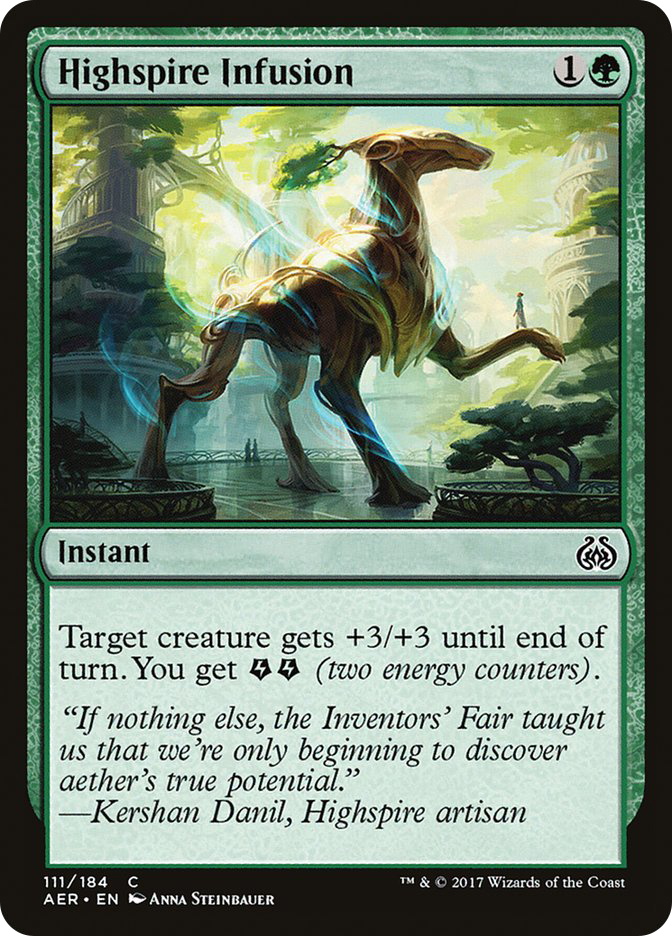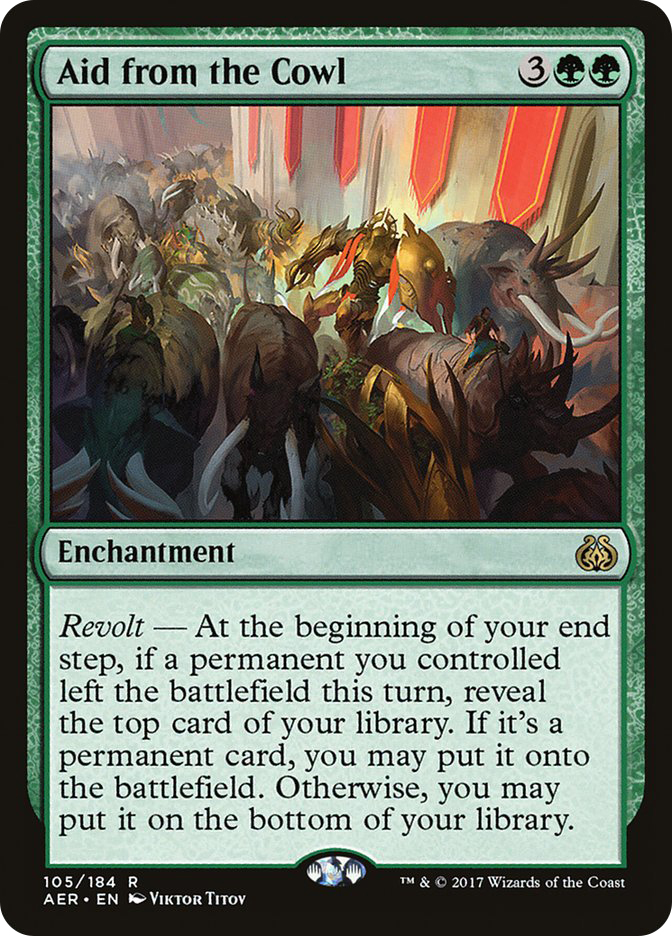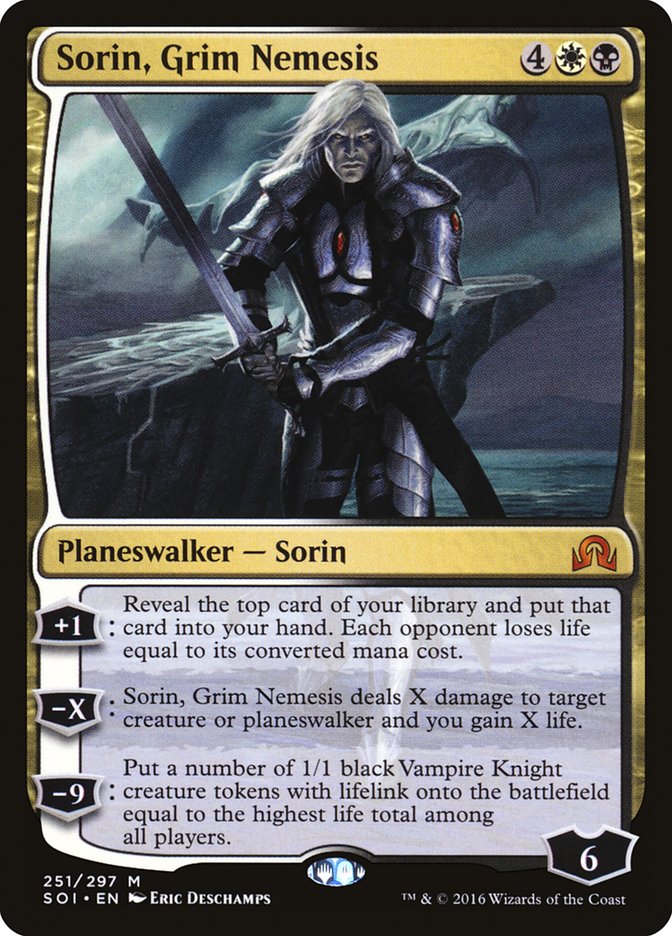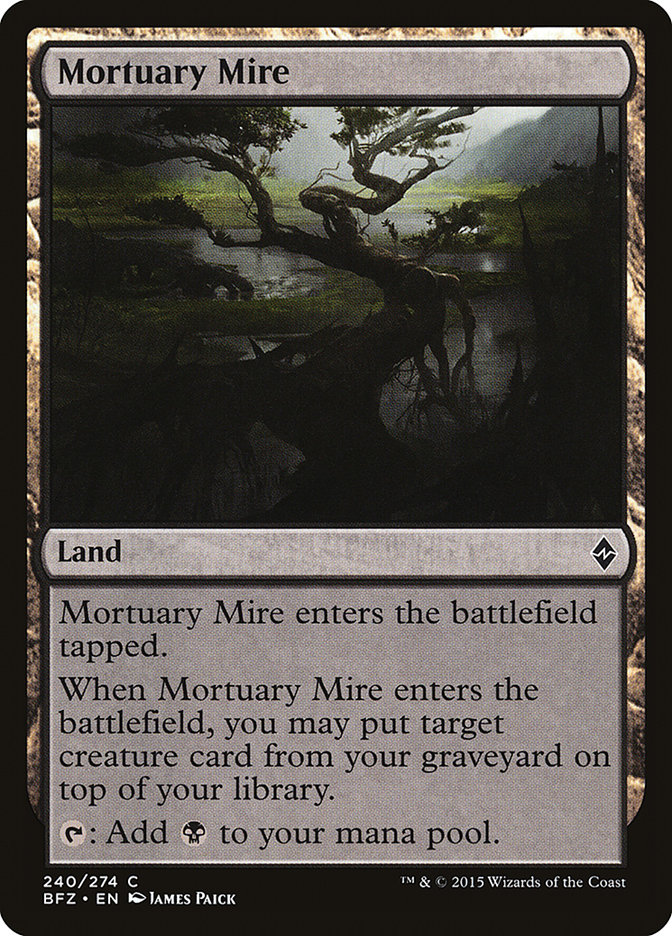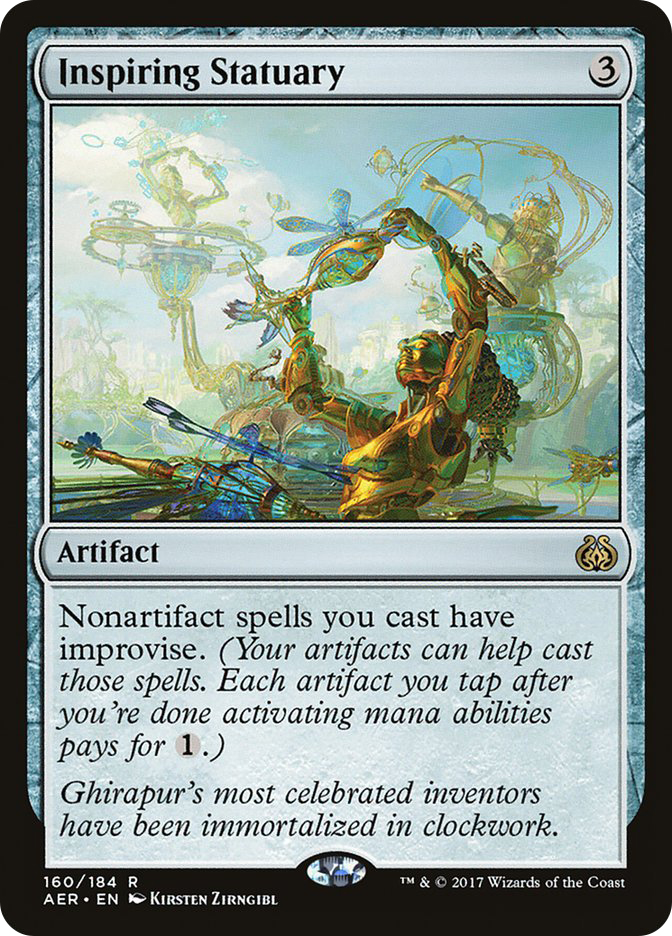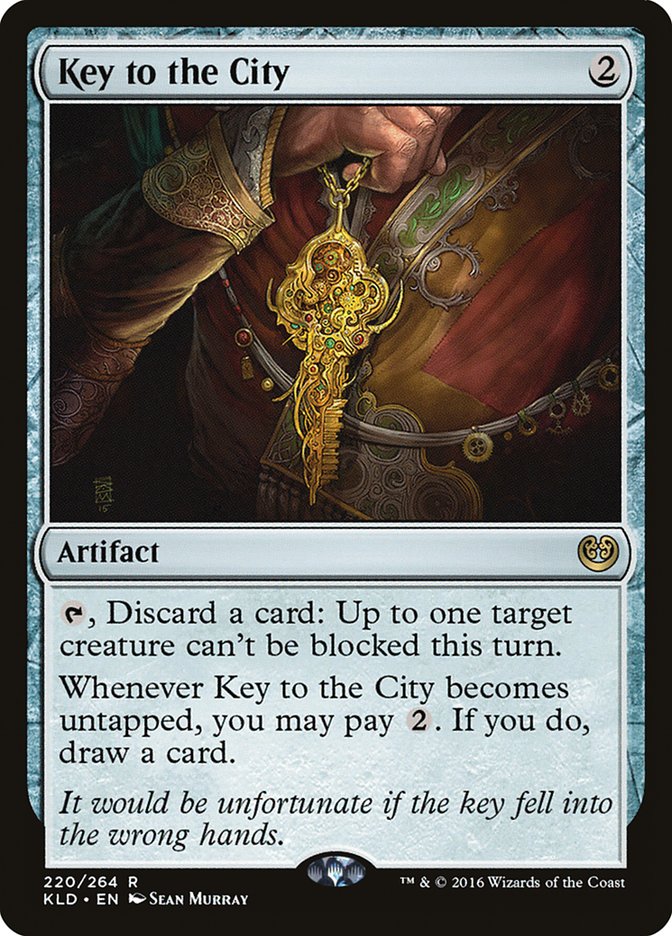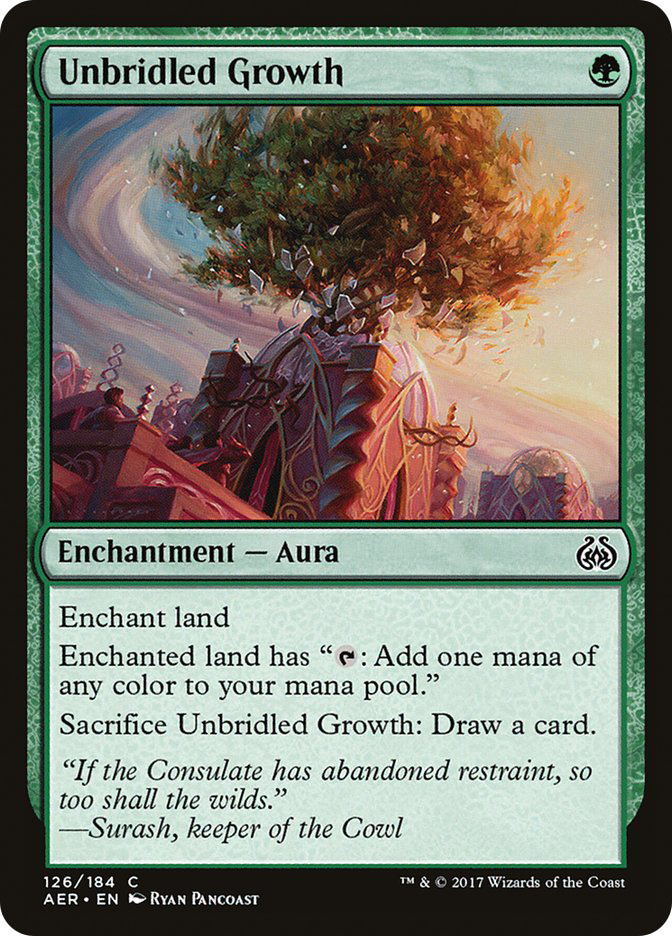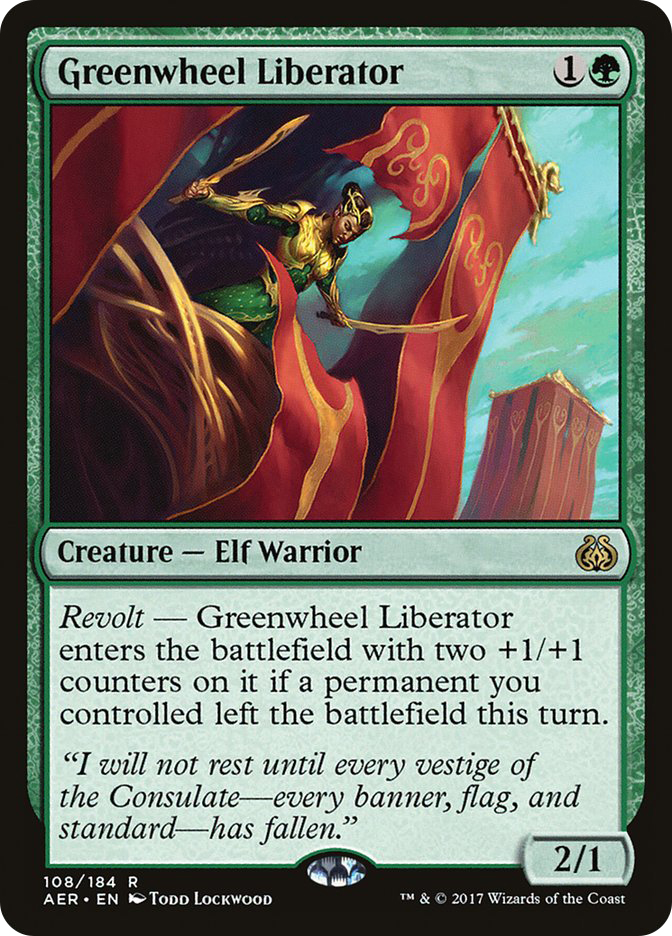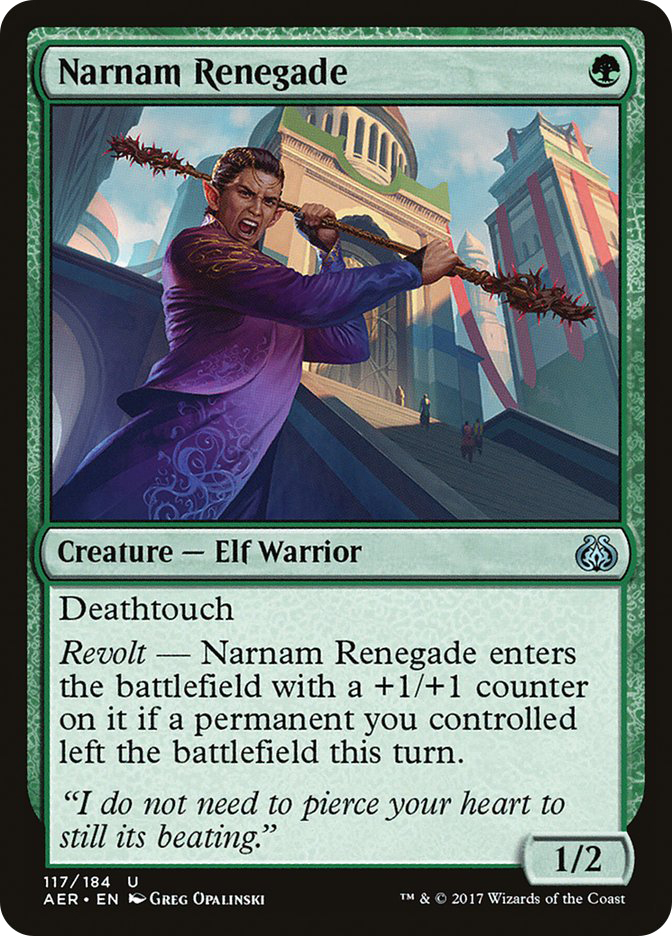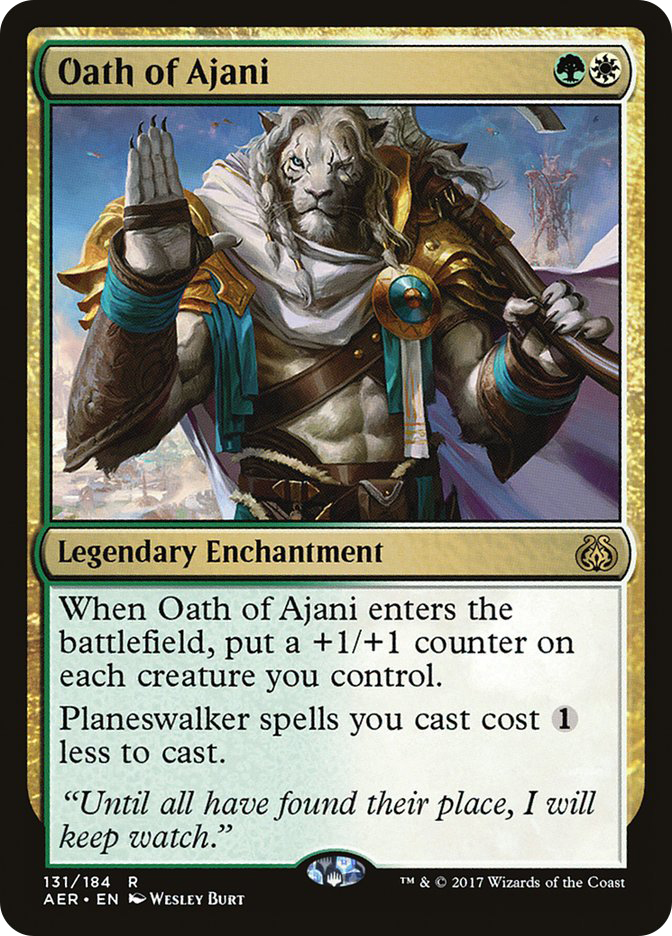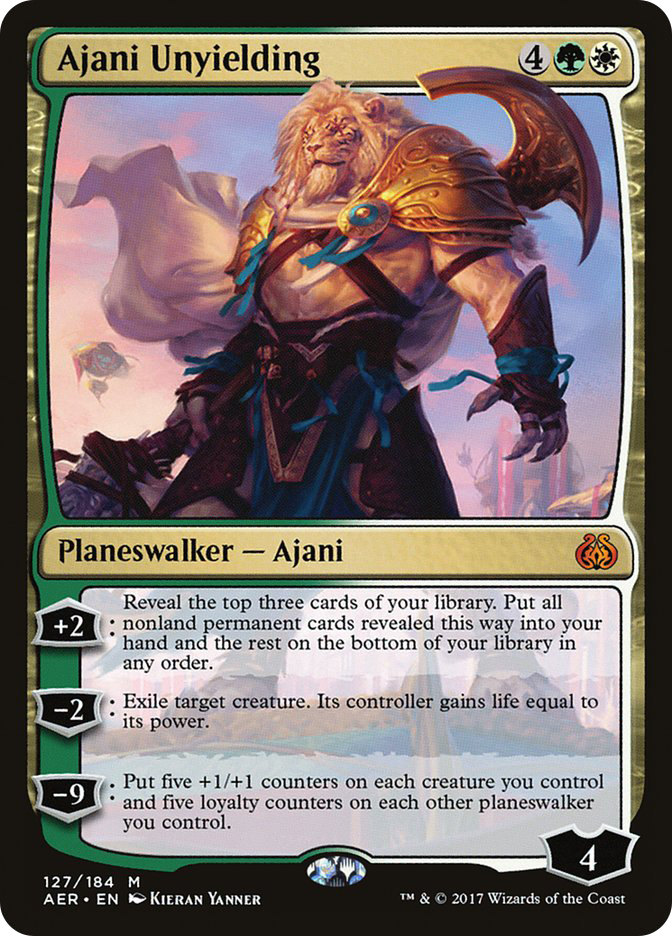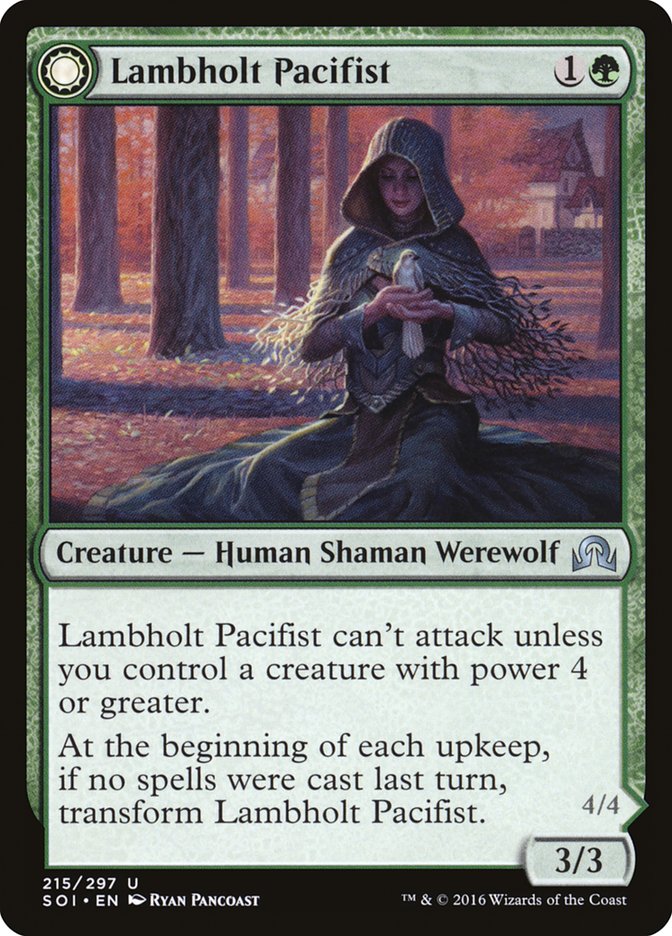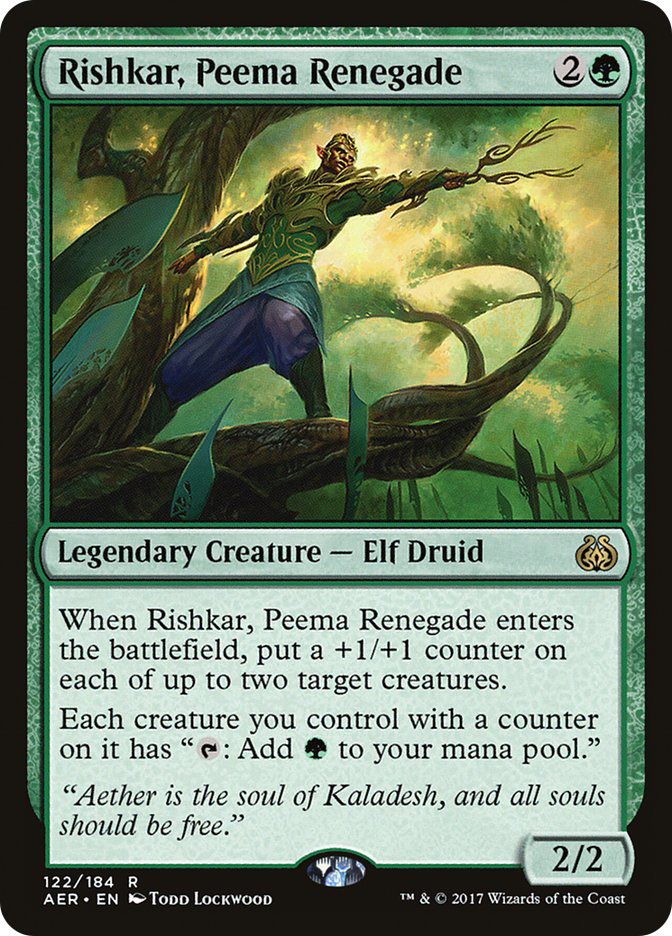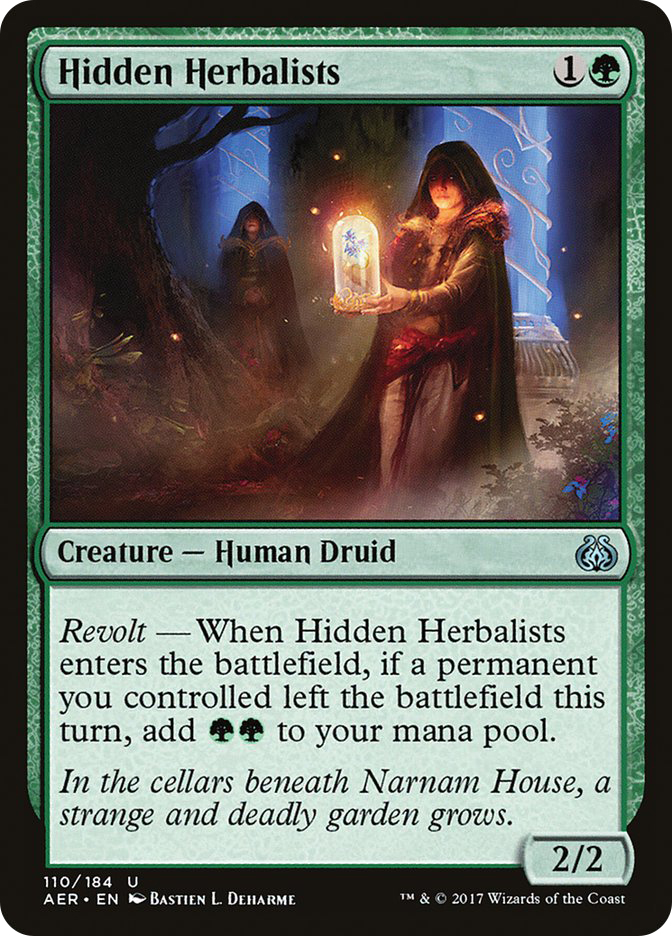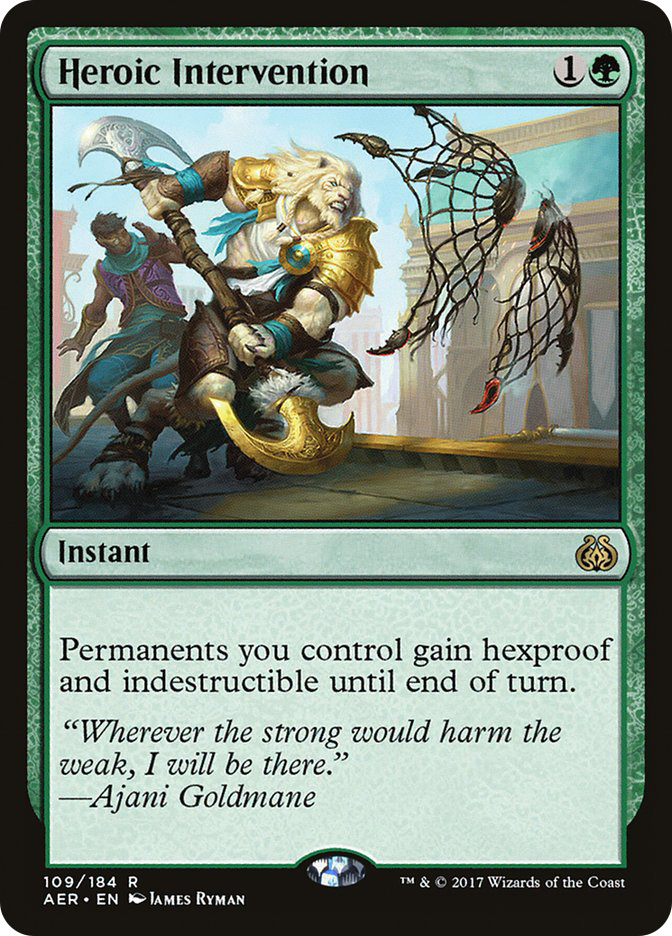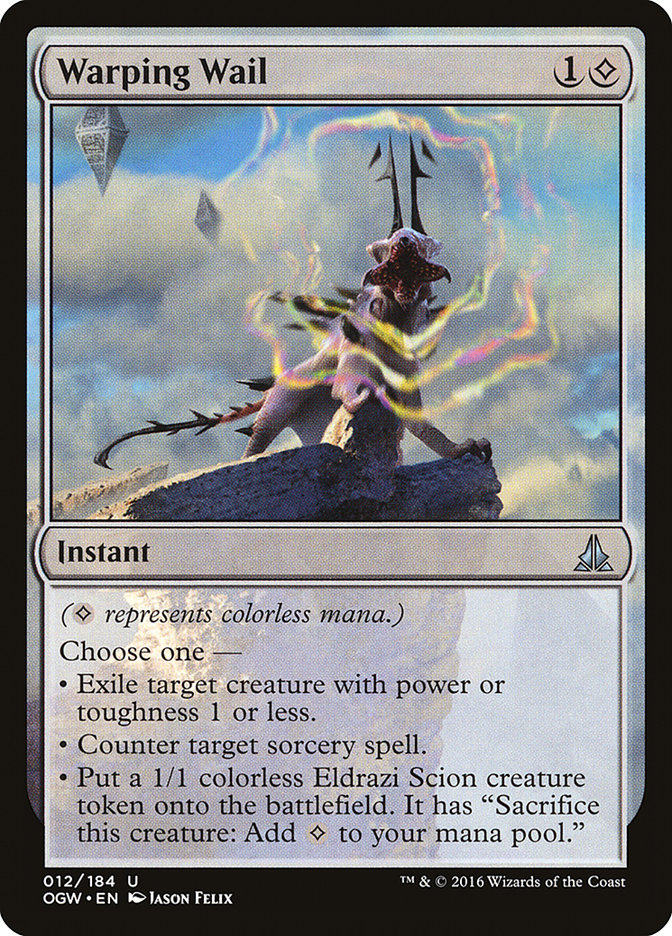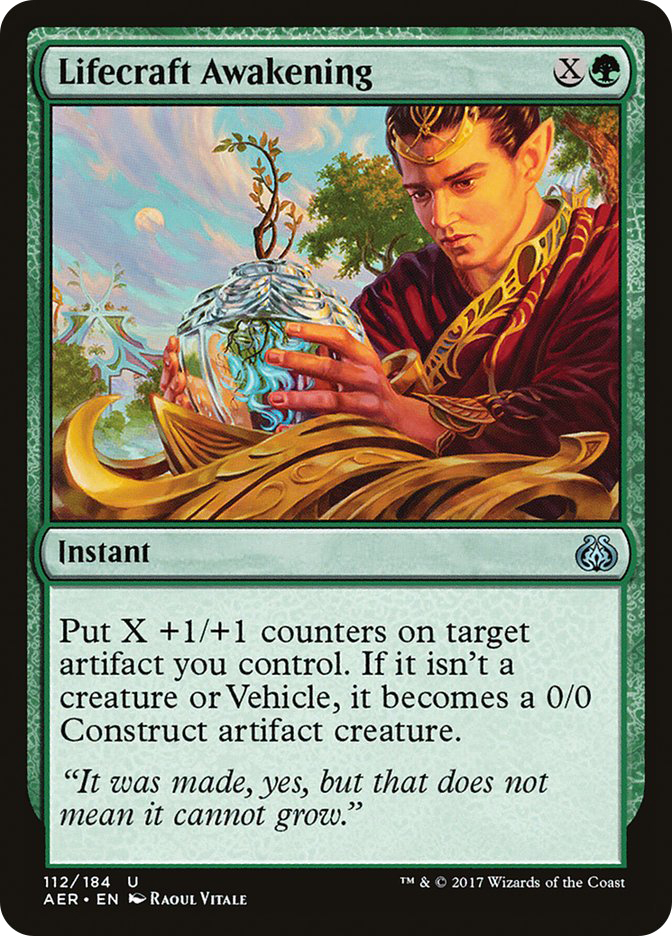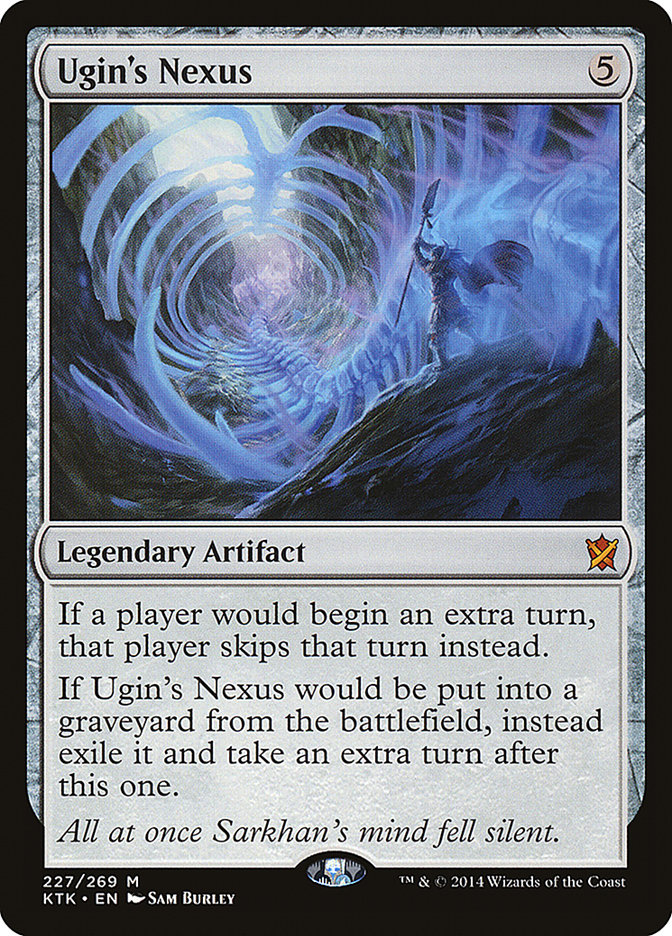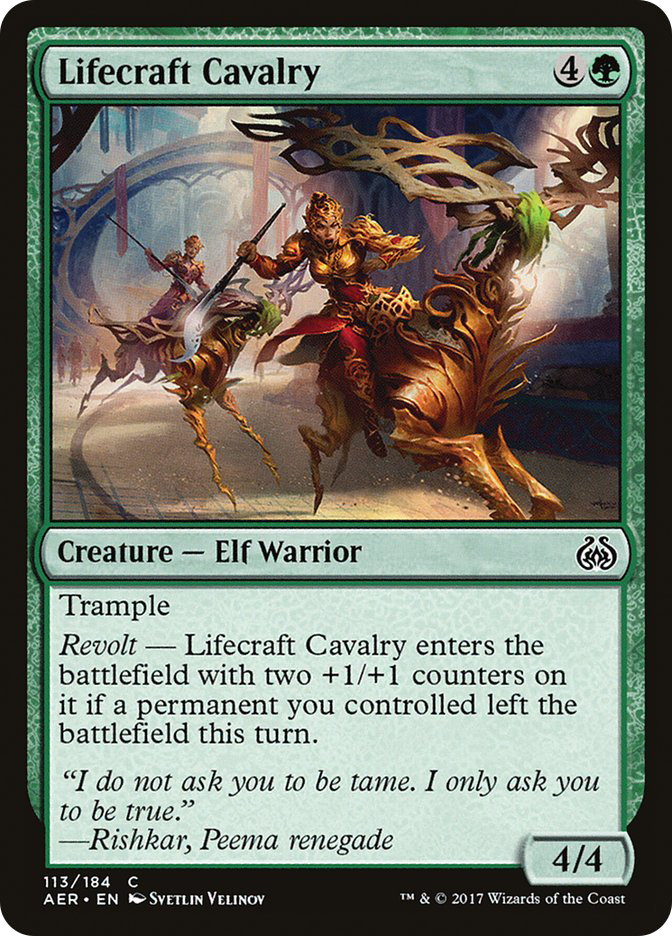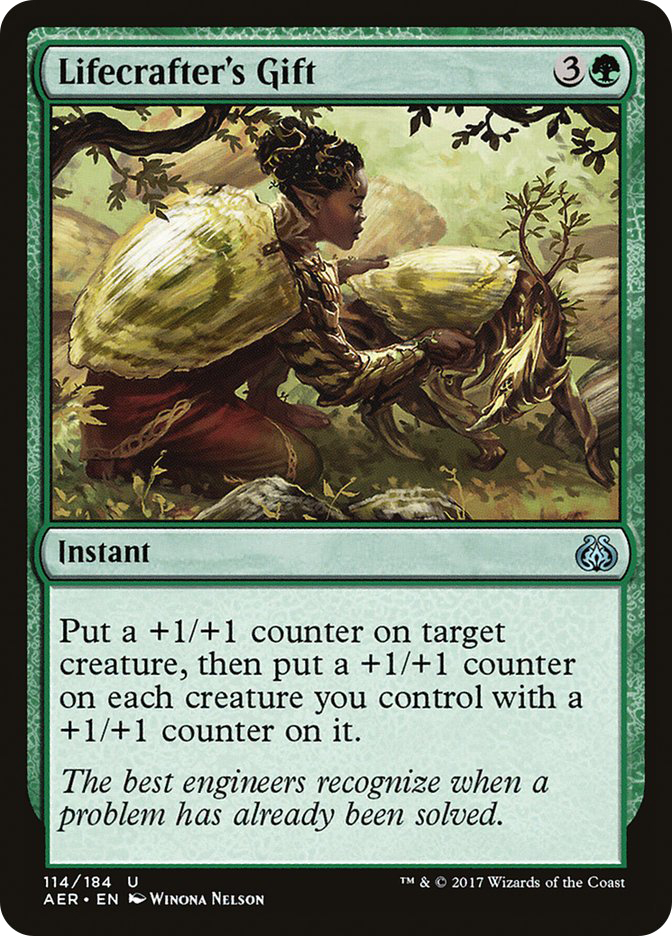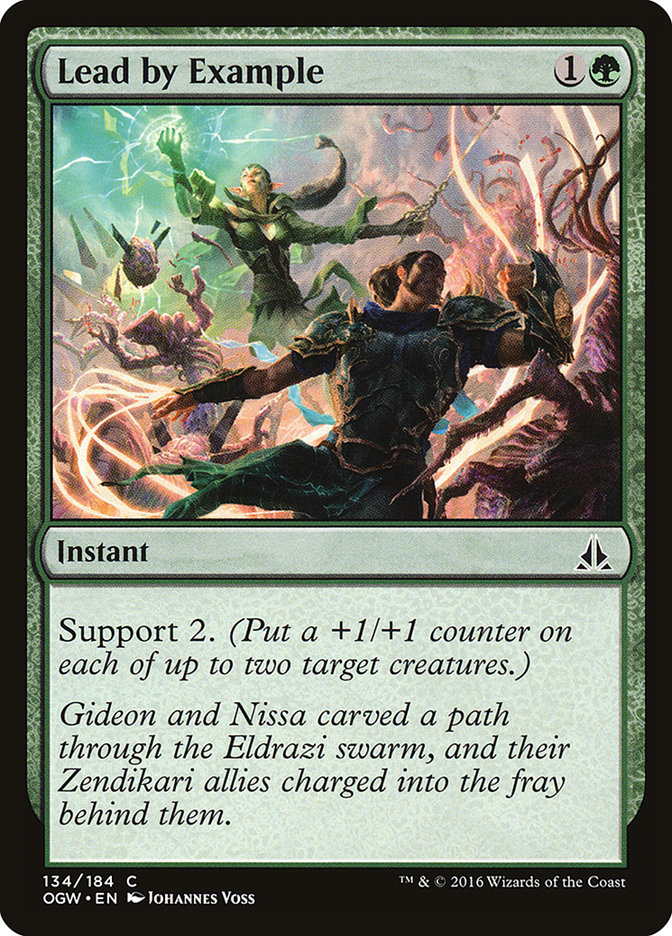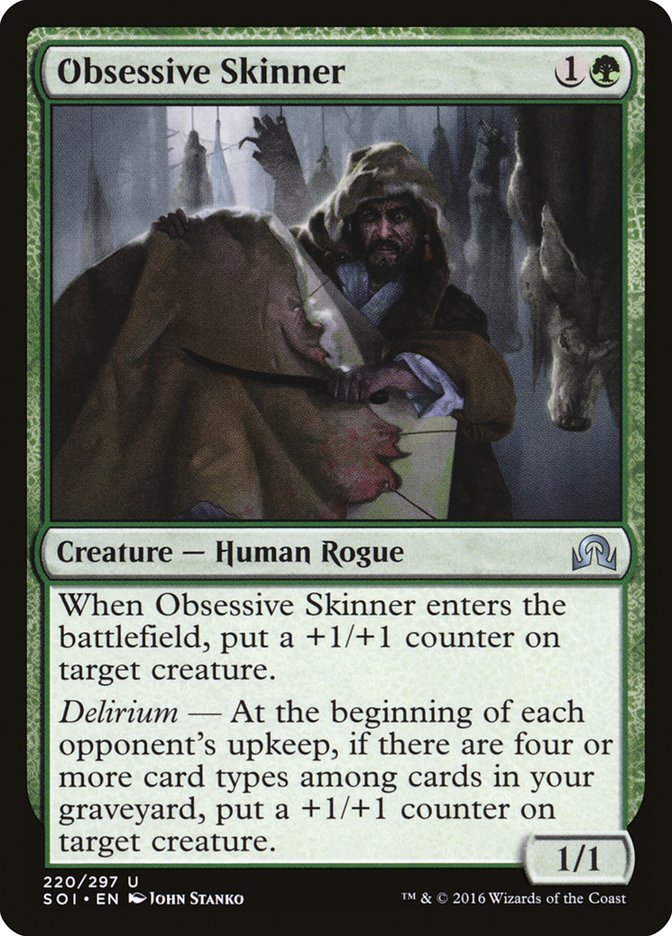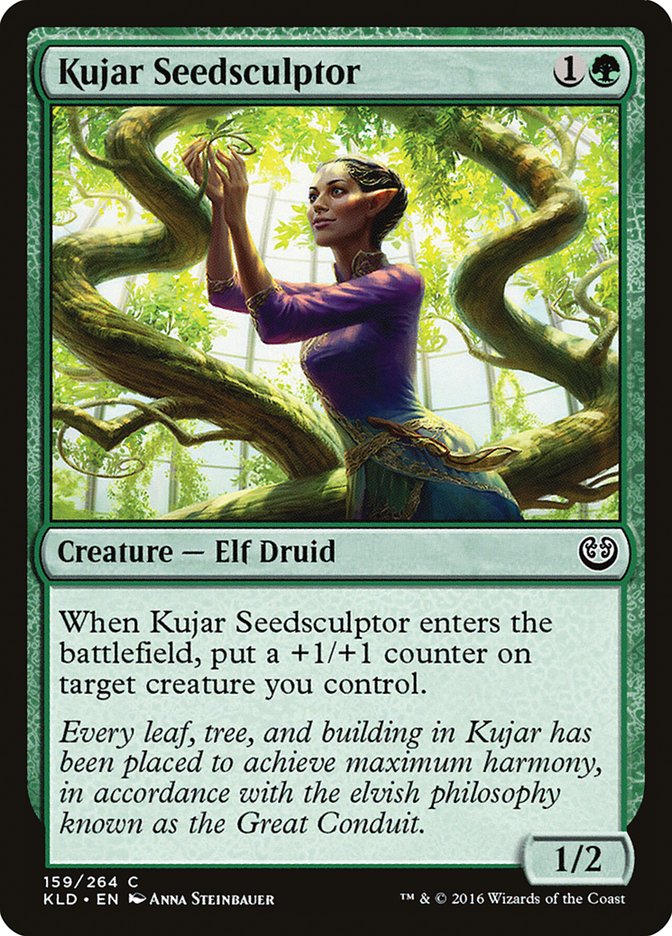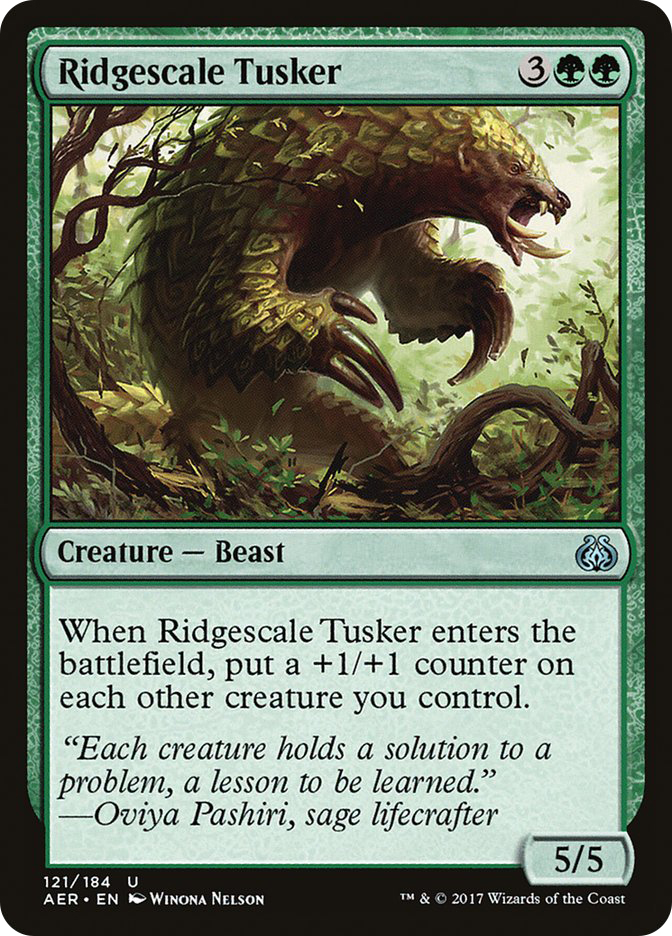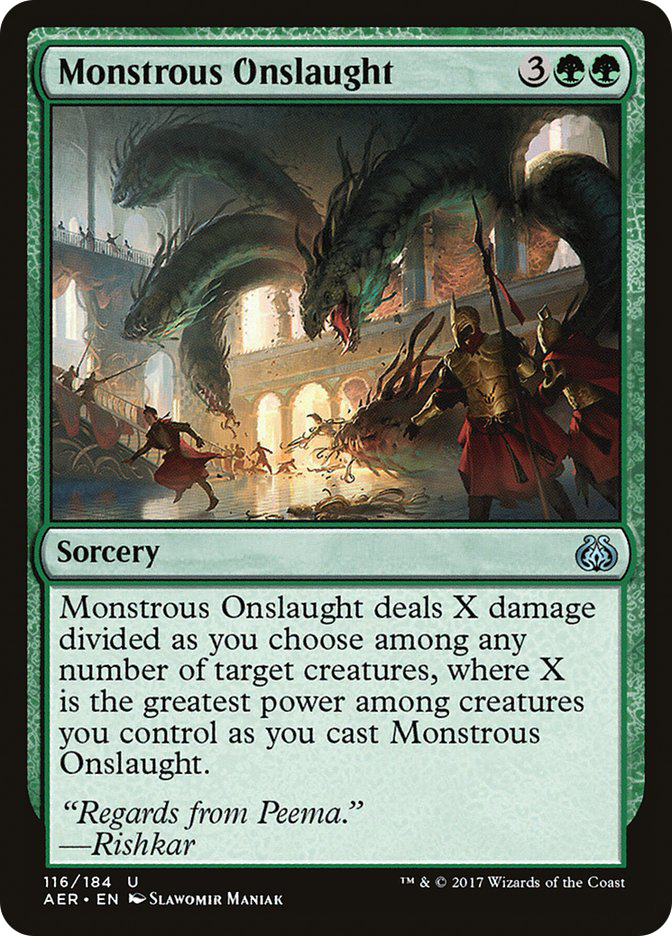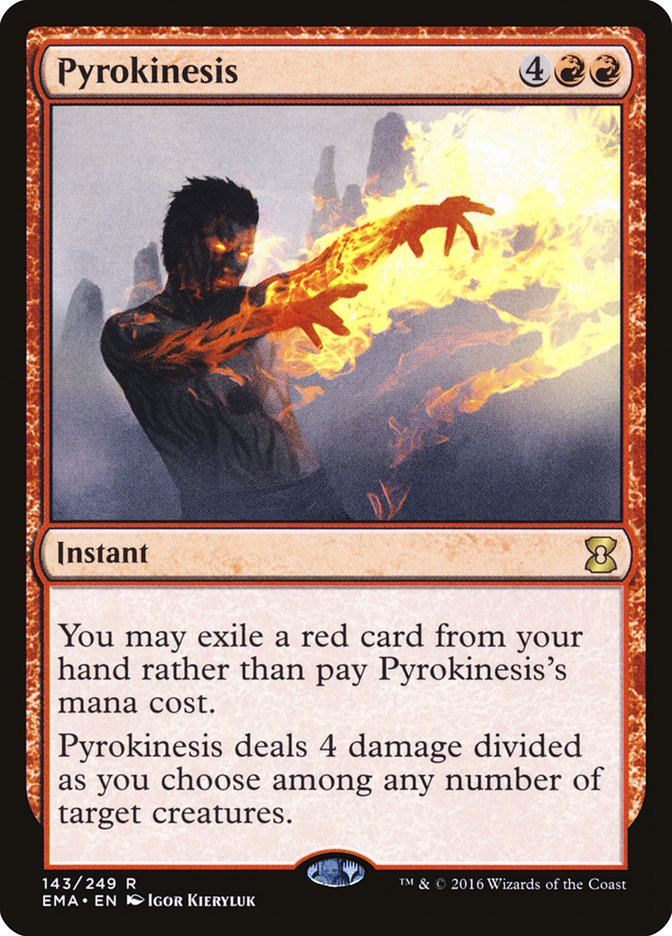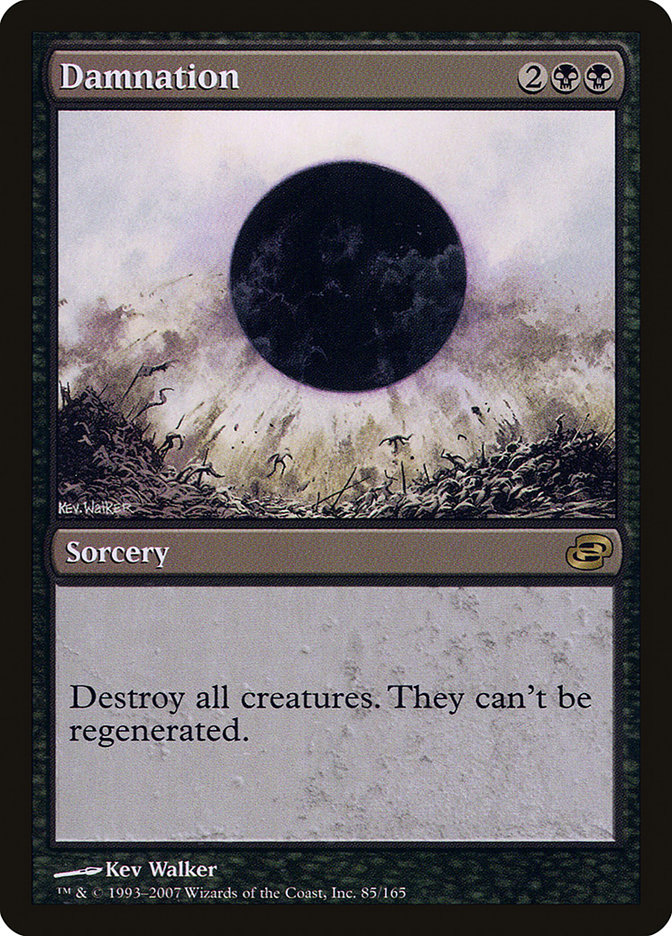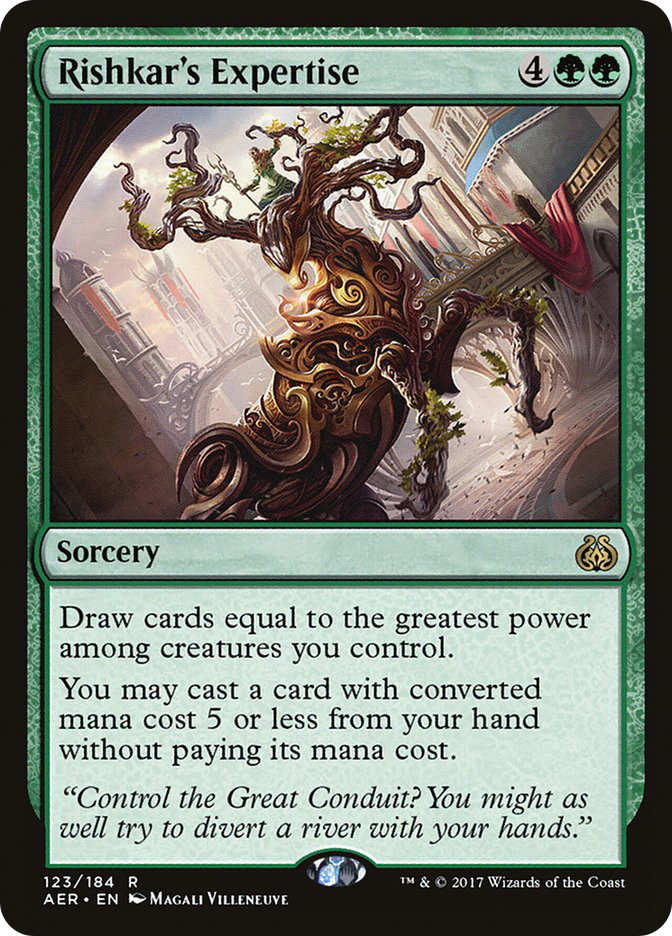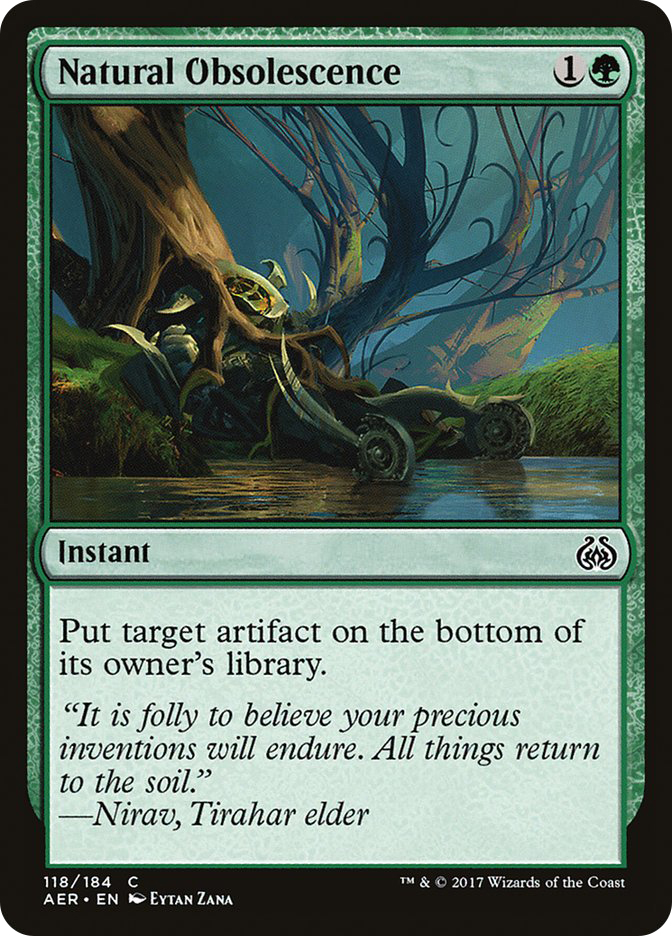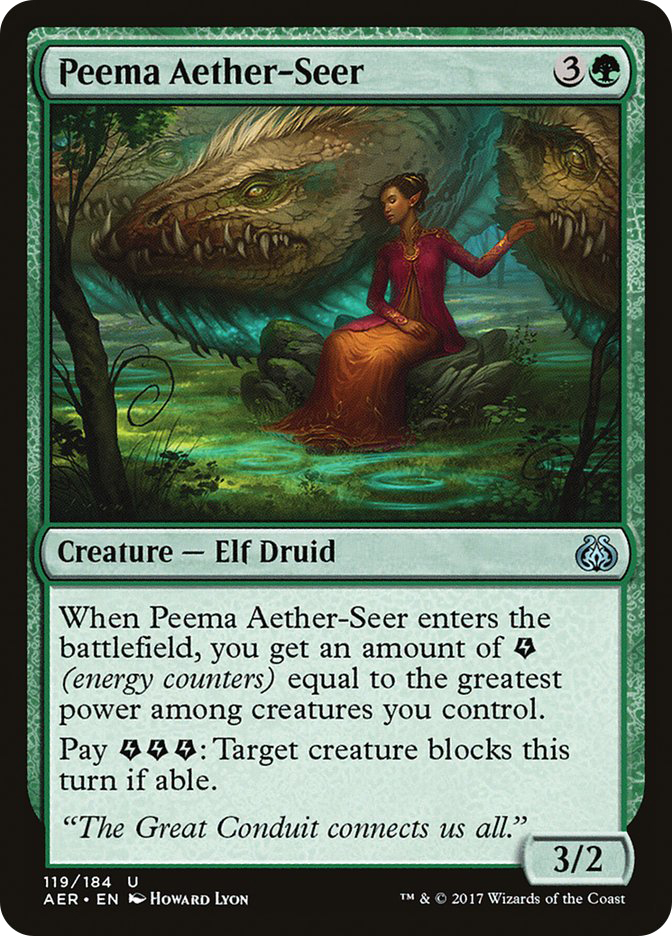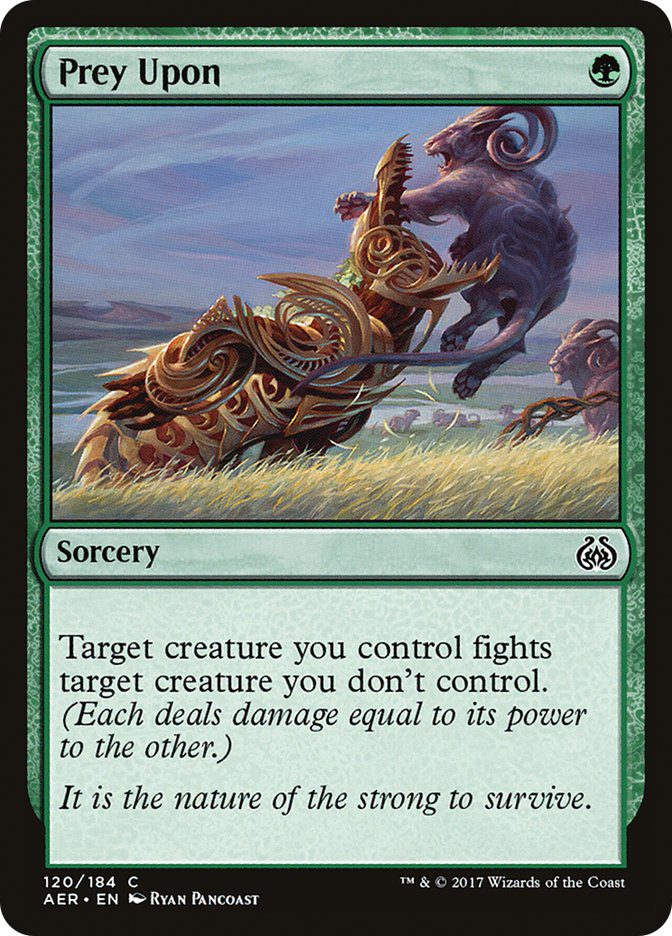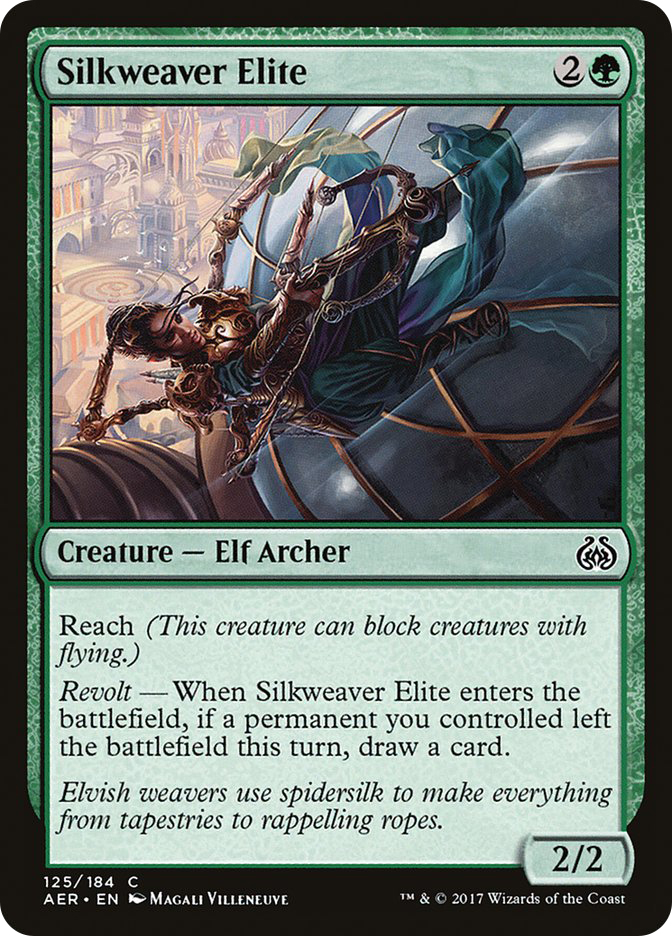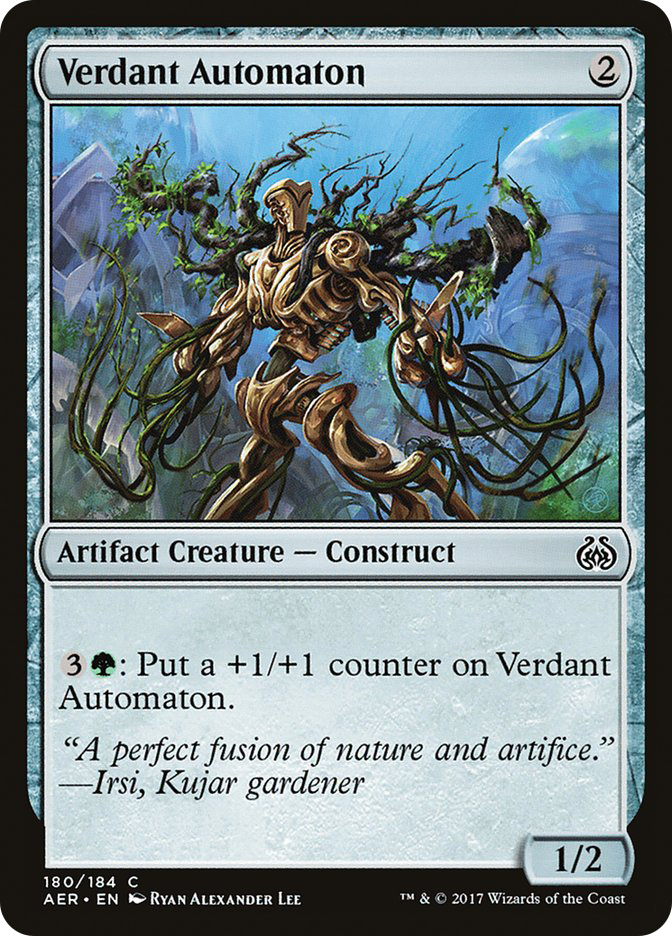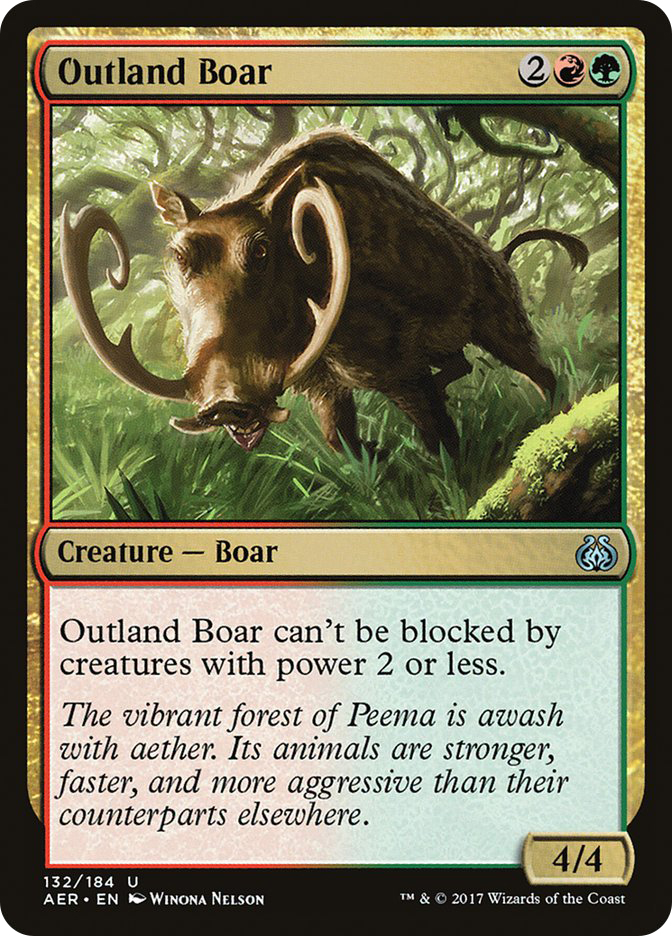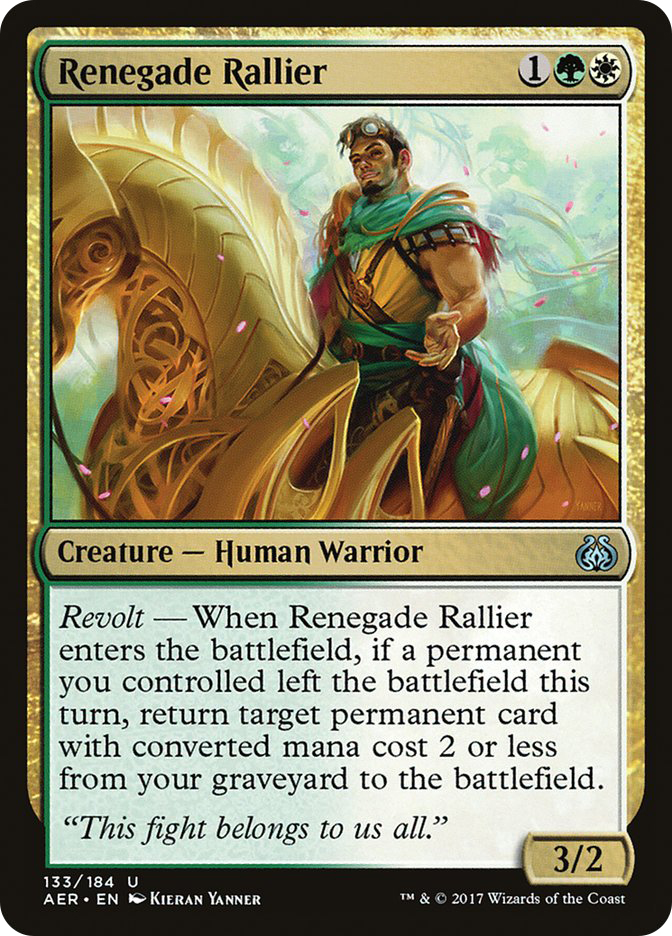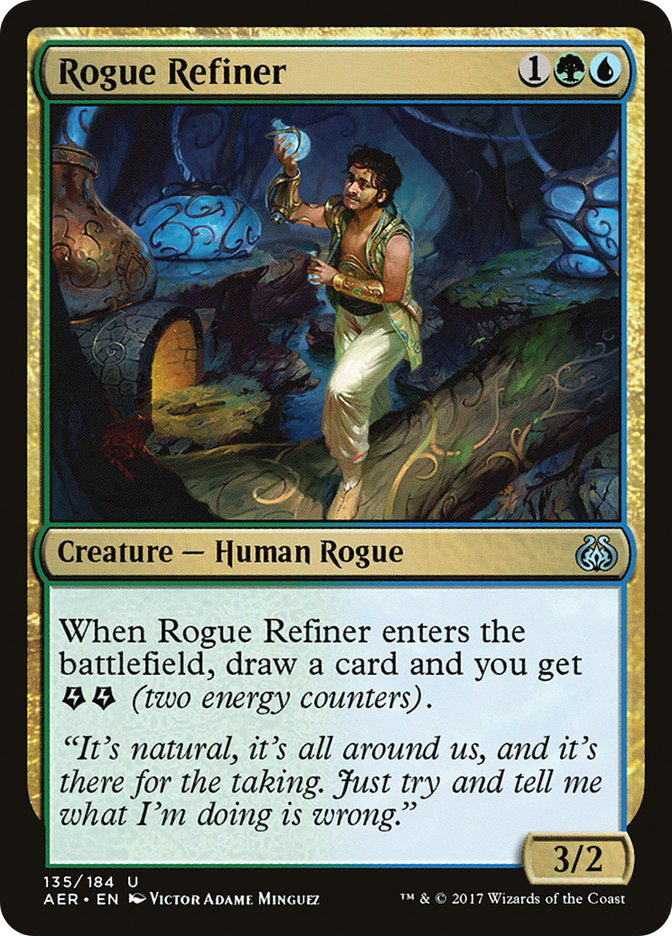Aether Revolt is a unique set with some exotic themes, cards, and mechanics that are pushed in unusual ways. Building decks for this new format is a very different puzzle from what we usually face when working with a new set. Outside of how strange of a card file we’re dealing with, all of the existing cards have brand new meaning, since three of the most important cards in the previous format were just banned.
This is the first set of Standard bans in five-and-a-half years. The last time before that was six years earlier. This is an uncommon phenomenon in Standard. Not only does it not come up often, it also speaks to just how crazy busted the format had to be in order for things to have gotten this far.
This week, I’d like to take a look at the cards of Aether Revolt, how to use them, and the new format we find ourselves in. The style of card design Wizards of the Coast is pushing in this block is a very combo-centric one, and one in which every card plugs into several other cards in interesting ways, the values of the cards fluctuating depending on which other cards you play alongside them.
Of course, on the flipside, WotC has also been promoting a style of card design in which there are a few super-powerful cards per set that have an overwhelming impact on the rules of engagement, what’s possible. While three of those cards were just banned, many more remain. In addition to the rest of the previous top-tier cards…
…the banning of Smuggler’s Copter, Reflector Mage, and Emrakul, the Promised End opens up more of the most powerful cards that may or may not have had a Tier 1 home.
Okay, let’s jump into the green cards from Aether Revolt.
A blazing start, I see…
While this set actually has a disproportionately large number of potentially Constructed-playable cards, there are still some that were designed primarily with Draft and Sealed Deck in mind. Aether Herder is one such design, with a Draft-level rate of efficiency and very low Constructed novelty. This is why we have the Lax and the Saxe.
Another Draft-rate card with very low Constructed novelty.
It might be easy to dismiss Aetherwind Basker as too expensive for Constructed; however, it does provide a few things we might be interested in in the right deck. First of all, it produces a lot of energy, both when it enters the battlefield and when it attacks. This energy can be used for some big purpose, such as Aetherworks Marvel, or just used to pump the Aetherwind Basker with its own ability, which obviously works well with its trample.
With a Spontaneous Artist on the battlefield, you may be able to drop an Aetherwind Basker and win immediately. If you have two other creatures besides the Basker and the Artist, you’ll net seven energy (counting paying one energy to give the Basker haste). That seven energy can give the Basker +7/+7, which could be enough to win if the Artist is hitting this turn and hit last turn (perhaps using its own energy to attack immediately).
With enough creatures on the battlefield, Lightning Runner can combine with Aetherwind Basker to attack as many times as you want.
“This is pretty close to the definition of win-more.”
Nevertheless, lots of combos start out as Magical Christmas Land fantasies. We can’t always know when one will lead to a powerful and important fixture in the format. You know how many people thought Aetherworks Marvel was Magical Christmas Land stuff too?
Here’s a really bad deck that just might help us find our way to a broken one. We’ll get to the good decks a little further down…
Creatures (21)
- 2 Longtusk Cub
- 4 Spontaneous Artist
- 4 Servant of the Conduit
- 4 Greenbelt Rampager
- 3 Aetherwind Basker
- 3 Druid of the Cowl
- 1 Lightning Runner
Planeswalkers (2)
Lands (20)
- 10 Forest
- 2 Mountain
- 4 Cinder Glade
- 4 Game Trail
Spells (17)

Tuning an existing archetype is a very different process from trying to find a new one. Rather than trying to find the exact best version of the above deck, we’re just looking to explore interactions, trying new combinations of cards.
There’s no shortage of two-cost mana creatures, but Druid of the Cowl has one important advantage: it’s got three toughness.
The printing of Shock would have been interesting anyway, but as fate would have it, it is simultaneously one of the best answers to Toolcraft Exemplar and to the so-called “Copy Cat” combo, Saheeli Rai plus Felidar Guardian.
Even if Saheeli Rai starts at higher loyalty from a few turns of using its plus ability, Shock can break up the combo. Eventually, Felidar Guardian is going to have to blink Saheeli Rai. When Saheeli Rai comes back, it will have just three loyalty. When Saheeli Rai goes to copy Felidar Guardian, it will drop to just one loyalty.
Greenbelt Rampager is a fantastically strong Magic card.
Even if you don’t try, even if you don’t do anything fancy, Greenbelt Rampager is so shockingly efficient of a creature, it might be worth playing as a 3/4 for GGG that you can pay in installments.
Turn 1: Forest, Greenbelt Rampager
Turn 2: Forest, replay Greenbelt Rampager, replay and keep Greenbelt Rampager
That is a lot more efficient than an Acridian…
Acridian was a compelling tournament card back in the day, but these are very different times. A creature costing one less and getting one more power, plus a lot more flexibility, is not necessarily a guarantee of its effectiveness.
Attune with Aether is sort of like a tapped land, costing one mana upfront but giving you whatever color you need. However, with Greenbelt Rampager, it sort of nets mana. Instead of being down a mana for the Attune, you end up being able to cast the Greenbelt Rampager for just a single mana. It costs two mana between the two cards, plus you got the basic land of your choice.
Servant of the Conduit is a powerful accelerator, but it also has a bullseye on its head in some matchups. If someone kills your Servant of the Conduit on turn 2, you can actually have a pretty exciting turn 3, dropping both a Greenbelt Rampager and a two-drop.
Paradox Engine is an oddball that is basically all about unfair combos. There are tons of ways to go infinite with it, and this particular deck tries to set up Greenbelt Rampager plus Servant of the Conduit plus Paradox Engine. Another mana creature and we can make arbitrarily large mana. We’ve also got Spontaneous Artist plus Greenbelt Rampager plus Cryptolith Rite plus Paradox Engine as an additional loop to build on, as well as Greenbelt Rampager plus Cryptolith Rites plus Paradox Engine plus Longtusk Cub. Even when our combos produce arbitrarily large mana, that doesn’t even necessarily mean victory; however, cards like Lifecrafter’s Bestiary can be used to leverage such loops for a win.
While Greenbelt Rampager may prove the key to some crazy or only medium-crazy combo deck, its “fair” (or fair-ish) applications might be even more attractive. For instance, it slots perfectly into G/R Energy and may be enough to push the archetype into Tier 1.
Creatures (20)
- 4 Voltaic Brawler
- 4 Bristling Hydra
- 4 Electrostatic Pummeler
- 4 Servant of the Conduit
- 4 Greenbelt Rampager
Lands (21)
Spells (19)

In addition to gaining a 3/4 for one, we’ve also gained access to a new pump spell that we might be interested in, perhaps in place of Larger Than Life or Built to Smash or Uncaged Fury.
Highspire Infusion is not exactly breathtakingly efficient, so it’s very possible that we might not want to use it despite it both pumping our creatures and producing energy to fuel our combos. That said, the synergy is so good with Electrostatic Pummeler, we’d do well to try it. If we get an extra double because of it, it will effectively be four damage more than Uncaged Fury, more stackable, and a mana cheaper.
The good cards are coming, I swear! Alphabetical has the potential to be brutal, is all…
Aid from the Cowl isn’t all that likely to be good; however, it is a mana-cheat, a possible source of card advantage, and another option to consider for Aetherworks Marvel. For instance:
Creatures (8)
Planeswalkers (2)
Lands (21)
Spells (29)

Aid from the Cowl is sort of like an easier-to-trigger Aetherworks Marvel that only plays the top card, rather than the best of the top six. However, with Conduit of Ruin, we can make sure that’s Ulamog, the Ceaseless Hunger.
Likewise, Sorin, Grim Nemesis’s +1 ability takes on new meaning when we can set the top of our library to Ulamog. Sorin is also a totally respectable reveal to Aetherworks Marvel anyway.
Mortuary Mire is yet another way to make sure Aid from the Cowl and Sorin hit Ulamog (possibly with Key to the City discarding the Eldrazi when we’re nowhere near casting it). Traverse the Ulvenwald makes the first copy of Mortuary Mire a bit more valuable than it would otherwise be.
Inspiring Statuary is one of the most likely broken cards in the new set, in my opinion. The opportunity cost is low, since the card’s floor is basically a three-cost artifact mana source. The ceiling, however, is very impressive in many places, such as in a Paradox Engine deck.
When used with Key to the City, Inspiring Statuary turns the Key to the City into a Mind Stone, except you also have the option to draw an extra card every time it untaps, if you want. This is an extremely powerful option that I could imagine showing up in a variety of decks that are nowhere near as all-in as the above, particularly if the deck was already in the market for graveyard or madness cards.
Unbridled Growth is an interesting new way to do a cantrip, fixing our mana early and then cycling later once we’re set up. Interestingly, we can also use it to ensure we trigger Revolt the turn we drop the Aid from the Cowl. Woodweaver’s Puzzleknot, Evolving Wilds, and Vessel of Nascency are all great sources of Revolt, but they all cost mana. Getting to trigger Revolt for no additional mana? That’s interesting.
Speaking of triggering with Revolt for no additional mana…
Gideon is on the short list for most powerful cards in the format, so finding new ways to make even greater use of him is very compelling. If we use Gideon in a deck with Revolt, we can use his -4 ability on a key turn to make sure we get the triggers we need. For instance:
Creatures (20)
- 4 Thraben Inspector
- 4 Greenwheel Liberator
- 2 Rishkar, Peema Renegade
- 4 Solemn Recruit
- 4 Walking Ballista
- 2 Narnam Renegade
Planeswalkers (8)
Lands (22)
Spells (10)

I’ve got a feeling that making Revolt Aggro work is going to involve finding good ways to reliably and efficiently trigger it early. Greenwheel Liberator, for instance, is exciting as a 4/3 for two, but it starts getting a lot less interesting if we can’t cast it on turn 2.
Greenwheel Liberator might be pretty close to a 4/3 for two in Modern, but that’s not necessarily even impressive for the format. In Standard, I’m guessing it’ll be a little overrated, but it’s still worth exploration.
Walking Ballista looks pretty good to me. Getting to play a two-drop Mogg Fanatic in green or blue or white decks is already interesting. Beyond that, it’s effectively got “Multikicker 2: Get a +1/+1 counter.” What’s more, you can potentially sink extra mana into it later, continually pumping it, if things stall out.
In a Revolt deck, Walking Ballista is a potential zero-cost source of Revolt, either sacrificed for damage or just cast from your hand for zero (going to the graveyard immediately).
Solemn Recruit doesn’t even need to trigger Revolt to be an interesting card. A 2/2 with double strike is not far off, and once you factor in the +1/+1 counters, it gets pretty exciting. If you can trigger Revolt, however, it quickly grows into a must-kill threat that does a lot more damage than almost any other three-drop.
Narnam Renegade may have less upside when triggered, but like Solemn Recruit, it depends a lot less on Revolt to be good. A 1/2 deathtouch creature for one is already pretty close. It’s interesting, figuring out how hard to work. It’s also interesting figuring out the value of a 2/3 deathtouch in a world where Thraben Inspector is one of the best cards.
Speaking of Thraben Inspector, sacrificing the Clue counts towards Revolt. Legend-ruling Oath of Nissa or Oath of Ajani does, as well.
Oath of Ajani is sort of a two-cost +1/+1 to your team with plenty of +1/+1 counter synergies. It also starts to pay you back when you cast Nissa or Gideon. Of course, there are plenty of ways to play the card that make greater use of the acceleration. For instance:
Creatures (18)
Planeswalkers (10)
Lands (25)
Spells (7)

Oath of Ajani can be another “Anthem” effect for a token deck, but it can also help us drop expensive planeswalkers like Ajani Unyielding ahead of schedule.
Ajani Unyielding is fairly modest as far as six-cost planeswalkers go, but it does provide valuable utility in the form of reliably creature removal. It also provides enough extra cards to rip open a game that stalls out.
Lambholt Pacifist might be the single card that has gained the most from Aether Revolt and the new bans. The banning of Smuggler’s Copter leaves an opening at the two-spot. It also makes Nissa, Voice of Zendikar much more playable. The printing of Shock makes the third point of toughness extra valuable. The printing of Rishkar, Peema Renegade and Oath of Ajani means we’ve got a lot more ways to make sure the Pacifist is willing to get its hands dirty.
Rishkar, Peema Renegade looks fantastic! We get 4/4 worth of bodies, spread out efficiently. It produces mana and sometimes gets a discount from putting one or two counters on creatures on the battlefield that then immediately tap for mana (assuming they’re not summoning sick). It can lead to some pretty crazy interactions with cards that give +1/+1 counters to your whole team, as well as some loops (like Paradox Engine fanciness).
Playing a second Rishkar, Peema Renegade is actually way more useful than most legendary creatures would be. We get two +1/+1 counters, can keep the one that’s not summoning sick, and we get a Revolt trigger. We can also use the legend rule to trigger Archangel Avacyn!
Rishkar really doesn’t need to be doing anything fancy. For instance, a couple in B/G Delirium might be easy adds.
Creatures (21)
- 1 Kalitas, Traitor of Ghet
- 4 Sylvan Advocate
- 4 Gnarlwood Dryad
- 1 Decimator of the Provinces
- 1 Distended Mindbender
- 4 Ishkanah, Grafwidow
- 4 Grim Flayer
- 2 Rishkar, Peema Renegade
Planeswalkers (2)
Lands (22)
Spells (15)

The similarity to Burning-Tree Emissary is enough to warrant deeper consideration. I don’t see a good home for Hidden Herbalists in Standard yet, but here’s a Modern application:
Creatures (28)
- 2 Kird Ape
- 4 Wild Nacatl
- 4 Goblin Guide
- 4 Burning-Tree Emissary
- 4 Experiment One
- 2 Ghor-Clan Rampager
- 4 Reckless Bushwhacker
- 4 Hidden Herbalists
Lands (20)
Spells (12)

Heroic Intervention can be used in a creature deck to set up a devastating combat phase, whether attacking or blocking. It can also be used to beat sweepers or trade with removal. It could also be used in some sort of green “Copy Cat” combo deck, protecting either Saheeli Rai or Felidar Guardian.
While it’s an easy sideboard card, I’d love to use it in the maindeck of some kind of mono-green creature deck. Unfortunately, such a deck seems like it might be very vulnerable to Saheeli Rai plus Felidar Guardian itself.
Warping Wail is an interesting card to keep an eye on. It can allow anyone with reliable access to colorless mana a way to break up the Saheeli-Felidar combo, not to mention having countless minor applications and generally just trading with a number of threats.
Lifecraft Awakening is more of a Draft-worthy trick that makes artifact creatures particularly valuable and can lead to some surprise blocks when it seems like we’ve got no creatures.
In Constructed, it’s probably going to fall a little short unless we can make extra use of the +1/+1 counter synergies in an artifact deck, perhaps with the Metallic Mimic plus Animation Module combo (which lets us buy 2/2s for one, as often as we like, once we get it going). However, there are so many +1/+1 counter synergies, I would be surprised if it’s actually good enough. It is kind of sweet to cast on a Walking Ballista, I’ve gotta admit…
One other possible way to use the card would be if there was an artifact we had extra interest in animating. For instance, Key to the City becoming a creature would make it easier to tap without spending cards. Another fringe use might be as a cheap way to kill your own artifact (for instance, if Ugin’s Nexus was legal).
Hey, you never know!
Lifecraft Cavalry has a Draft rate and very low Constructed novelty.
Lifecrafter’s Gift seems largely targeted at Draft; however, it’s possible we could use it in an extremely dedicated +1/+1 counter deck. It may be two mana more than Oath of Ajani while providing just one extra +1/+1 counter, but it doesn’t require adding white mana, and it’s an instant.
Creatures (29)
- 4 Endless One
- 2 Verdurous Gearhulk
- 3 Armorcraft Judge
- 4 Winding Constrictor
- 4 Rishkar, Peema Renegade
- 4 Walking Ballista
- 4 Scrounging Bandar
- 4 Narnam Renegade
Planeswalkers (4)
Lands (23)
Spells (4)

While there’s a lot to like with the +1/+1 counter synergies, I’m not sure Lifecrafter’s Gift is a part of that. It looks a fair bit less efficient than Lead by Example, and it’s not like Lead by Example is breaking any records.
That said, Lead by Example has increased value now that both Winding Constrictor and Rishkar, Peema Renegade have increased the value of +1/+1 counters.
Winding Constrictor seems like it will be very impressive. A 2/3 for two is already not that far off, and once we’ve gotten a single extra counter from it, we may already have gotten our money’s worth. Opening with turn 2 Winding Constrictor plus turn 3 Rishkar, however, and now we’re really doing it. Now we’re attacking for four and have 8/9 worth of stats on the table, and that’s just two cards on the third turn.
Winding Constrictor can make for some absolutely devastating plays when combined with Nissa, Voice of Zendikar. For instance:
Turn 1: Endless One as a 1/1
Turn 2: Winding Constrictor, attack for one
Turn 3: Rishkar, attack for seven
Turn 4: Nissa, use her -2, attack for nineteen (!)
Another possibility is to use Nissa’s -2 and then drop another Nissa and -2 again, giving you an extra +4/+4. For example:
Turn 2: Any creature
Turn 3: Nissa, make a 0/1 Plant
Turn 4: Any creature and make a 0/1 Plant
Turn 5: Drop Winding Constrictor, use Nissa’s -2, drop another Nissa and -2, attack for well over twenty (!)
Scrounging Bandar may have +1/+1 counter synergy, but the same is true for Obsessive Skinner and Kujar Seedsculptor. The Skinner even has the dream of going big if we can reliably enable delirium, while the Seedsculptor has a bigger body if Shock proves a defining force.
That said, Scrounging Bandar has the extra utility of being able to move +1/+1 counters to other creatures, which could be sweet with Walking Ballista but will probably be at its best with Solemn Recruit.
Of course, we could try to merge Winding Constrictor with Oath of Ajani, but this carries with it added risks to the manabase.
Creatures (23)
- 2 Verdurous Gearhulk
- 3 Armorcraft Judge
- 4 Winding Constrictor
- 4 Rishkar, Peema Renegade
- 2 Yahenni, Undying Partisan
- 4 Walking Ballista
- 4 Narnam Renegade
Planeswalkers (4)
Lands (25)
Spells (8)

If we’re really going to go this route, I think I’d like to find a way to play even more white mana and actually get the good stuff, like Archangel Avacyn and Gideon, Ally of Zendikar.
Maulfist Revolutionary does promise 4/4 worth of bodies most of the time if you’re playing a +1/+1 counter deck. Trample might be a nice dimension for a +1/+1 counter deck. It even leaves you with a counter on the way out. However, with Rishkar, Peema Renegade and Nissa, Voice of Zendikar competing at the three-spot, it’s gonna be tough for it to make enough name for itself.
Ridgescale Tusker might be more of a Draft card, given the existence of Verdurous Gearhulk. However, it’s not actually definitely worse in a dedicated +1/+1 counter deck. If you’re trying to build such a deck on a budget, I would strongly consider it as a replacement.
Another use for the Constrictor is alongside Drana, Liberator of Malakir. You could be green-based:
Creatures (23)
- 3 Drana, Liberator of Malakir
- 2 Verdurous Gearhulk
- 2 Armorcraft Judge
- 4 Winding Constrictor
- 4 Rishkar, Peema Renegade
- 4 Walking Ballista
- 4 Narnam Renegade
Planeswalkers (4)
Lands (25)
Spells (8)

Or you could be black-based, taking advantage of Vampire synergies, which we’ll discuss a little later in the week.
One other important twist to remember with Winding Constrictor is the synergy with energy. When you’ve got a Constrictor, every time you get Energy, you’ll get an extra one. This can be particularly interesting when building towards energy loops like those with Whirler Virtuoso or Aethergeode Miner, as we’ll be working with in the days to come.
Monstrous Onslaught is a very unusual green card that sure seems like a pretty big color pie bleed. I guess the theory is supposed to be Polukranos, but that one was also weird, a bit of a bleed, and at least Polukranos had to actually fight the targets.
Monstrous Onslaught doesn’t get beaten by removal the way Polukranos did, it doesn’t make the creature fight, and it generally just functions like a green Pyrokinesis that only works if you agree to play some fatties.
It’s so weird that green would just get a damage-based sweeper like this. I mean, I get it, I guess, but it just seems so out of character. I guess it’s good to mix things up once in a while.
Of course, that was the same argument for Damnation.
While I could imagine using Monstrous Onslaught in a variety of miscellaneous decks, just for value, we can push it if we want to. It actually makes for an absolutely breathtaking follow-up to Rishkar’s Expertise.
Rishkar’s Expertise asks the exact same thing as Monstrous Onslaught, and when you cast Monstrous Onslaught after casting the Expertise, you get every mana of savings from the mana cheat ability. What’s more, a sweeper is one of the best things you could follow a big card draw spell with. Getting both in the same turn? Backbreaking.
Creatures (20)
- 4 Sylvan Advocate
- 3 Archangel Avacyn
- 3 Verdurous Gearhulk
- 4 Servant of the Conduit
- 3 Rishkar, Peema Renegade
- 3 Druid of the Cowl
Planeswalkers (4)
Lands (25)
Spells (11)

Maybe we’re supposed to go even harder into Monstrous Onslaught and Rishkar’s Expertise, but Gideon, Ally of Zendikar and Archangel Avacyn sure are enticing.
Costing just two instead of three (like Appetite for the Unnatural) is a big advantage. It also has the ability to hit something indestructible, and by sending the target to the bottom of the deck, it also dodges graveyard interactions.
Unfortunately, it has at least one important drawback in that it can’t hit enchantments. Stasis Snare is likely to be fairly popular and there may be G/W decks with no artifacts (or perhaps Servos tokens as the only artifacts). That said, as a sideboard card, this might not matter much.
Peema Aether-Seer is cute with Electrostatic Pummeler, but probably not high-impact enough for a four-drop, given competition like Bristling Hydra.
Draft rate, very low Constructed novelty, plus it’s a reprint that isn’t new to the format.
Draft rate, very low Constructed novelty.
Draft rate, very low Constructed novelty.
Draft rate, very low Constructed novelty
Okay! There we go!
Renegade Rallier is an efficient three-drop Human that wants you to play with one and two-drops that people want to kill. It’s particularly set up well for a fast aggro deck that can switch gears and grind with such great interactions as Thraben Inspector’s Clue. Besides, one of the most exciting two-drops you could possibly rebuy is Thalia’s Lieutenant.
Creatures (28)
- 4 Thraben Inspector
- 4 Thalia's Lieutenant
- 4 Lambholt Pacifist
- 4 Duskwatch Recruiter
- 4 Town Gossipmonger
- 4 Heron's Grace Champion
- 4 Renegade Rallier
Lands (23)
Spells (9)

Renegade Rallier gives a big, big boost to a strategy that wasn’t particularly hurt by the bannings. This is definitely a deck to watch.
While Rogue Refiner has less natural of a home, it sure does have a great rate. I mean, a 3/2 for three that draws a card is already interesting. If you can use the energy to good effect, you might be onto something.
Creatures (24)
- 4 Longtusk Cub
- 4 Bristling Hydra
- 4 Servant of the Conduit
- 4 Greenbelt Rampager
- 2 Rishkar, Peema Renegade
- 4 Rogue Refiner
- 2 Shielded Aether Thief
Lands (22)
Spells (14)

I dunno. I just think there’s a chance we might be able to find a very different path from any deck from the previous format. Maybe we’re supposed to go bigger with stuff like Glimmer of Genius and Torrential Gearhulk. Maybe we’re supposed to play Aetherworks Marvel as a card draw engine without being all-in. Maybe we’re supposed to play a third color. There’s a lot to try.
Implement of Ferocity is probably mostly for Limited, but you never know. It could be part of some Scrap Trawler chains, particularly since it has such good synergy with Walking Ballista.
Creatures (22)
- 4 Pilgrim's Eye
- 1 Wretched Gryff
- 4 Elder Deep-Fiend
- 4 Foundry Inspector
- 4 Scrap Trawler
- 1 Hope of Ghirapur
- 4 Walking Ballista
Lands (21)
Spells (17)

Walking Ballista has fantastic synergy with Scrap Trawler, counting as a zero in your graveyard, meaning anything can always get it back. You can always sacrifice it to make sure you’re getting something back when one of your artifacts is destroyed. It even has multikicker, so to speak, so when you replay it, it can come back much larger.
We’ve only barely scratched the surface of Aether Revolt, so let me know what cards and decks you’re most interested in, and I’ll see you Wednesday!
Brew!






